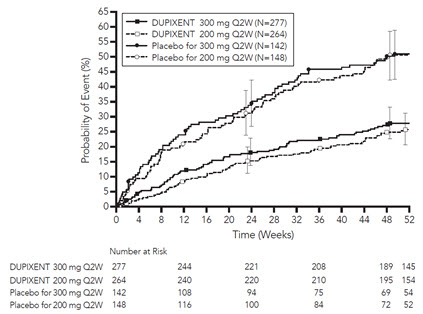DUPIXENT- dupilumab injection, solution
Dupixent by
Drug Labeling and Warnings
Dupixent by is a Prescription medication manufactured, distributed, or labeled by sanofi-aventis U.S. LLC, Regeneron Pharmaceuticals, Inc., Sanofi-Winthrop Industrie, Sanofi-Aventis Deutschland GmbH, Regeneron Ireland Designated Activity Company, Genzyme Ireland Limited. Drug facts, warnings, and ingredients follow.
Drug Details [pdf]
-
HIGHLIGHTS OF PRESCRIBING INFORMATION
These highlights do not include all the information needed to use DUPIXENT safely and effectively. See full prescribing information for DUPIXENT.
DUPIXENT® (dupilumab) injection, for subcutaneous use
Initial U.S. Approval: 2017RECENT MAJOR CHANGES
Indications and Usage, Atopic Dermatitis (1.1) 03/2019 Indications and Usage, Asthma (1.2) 10/2018 Indications and Usage, CRSwNP (1.3) 06/2019 Dosage and Administration, Atopic Dermatitis (2.1; 2.4) 03/2019 Dosage and Administration, Asthma (2.2; 2.4; 2.5) 10/2018 Dosage and Administration, CRSwNP (2.3; 2.4) 06/2019 Warnings and Precautions (5.1; 5.2; 5.3; 5.4; 5.5; 5.6; 5.7) 10/2018 Warnings and Precautions (5.2; 5.6) 06/2019 INDICATIONS AND USAGE
DUPIXENT is an interleukin-4 receptor alpha antagonist indicated:
- for the treatment of patients aged 12 years and older with moderate-to-severe atopic dermatitis whose disease is not adequately controlled with topical prescription therapies or when those therapies are not advisable. DUPIXENT can be used with or without topical corticosteroids. (1.1)
- as an add-on maintenance treatment in patients with moderate-to-severe asthma aged 12 years and older with an eosinophilic phenotype or with oral corticosteroid dependent asthma. (1.2)
Limitation of Use
Not for the relief of acute bronchospasm or status asthmaticus. (1.2) - as an add-on maintenance treatment in adult patients with inadequately controlled chronic rhinosinusitis with nasal polyposis (CRSwNP). (1.3)
DOSAGE AND ADMINISTRATION
Administer by subcutaneous injection. (2)
Atopic Dermatitis
Adults
- The recommended dose is an initial dose of 600 mg (two 300 mg injections in different injection sites), followed by 300 mg given every other week. (2.1)
Adolescents
Body Weight Initial Dose Subsequent Doses
(every other week)less than 60 kg 400 mg (two 200 mg injections) 200 mg 60 kg or more 600 mg (two 300 mg injections) 300 mg Asthma
- The recommended dose of DUPIXENT for adults and adolescents (12 years of age and older) is:
- an initial dose of 400 mg (two 200 mg injections) followed by 200 mg given every other week or
- an initial dose of 600 mg (two 300 mg injections) followed by 300 mg given every other week
- for patients requiring concomitant oral corticosteroids or with co-morbid moderate-to-severe atopic dermatitis for which DUPIXENT is indicated, start with an initial dose of 600 mg followed by 300 mg given every other week (2.2)
Chronic Rhinosinusitis with Nasal Polyposis
- The recommended dose of DUPIXENT for adult patients is 300 mg given every other week. (2.3)
DOSAGE FORMS AND STRENGTHS
CONTRAINDICATIONS
Known hypersensitivity to DUPIXENT or any of its excipients. (4)
WARNINGS AND PRECAUTIONS
- Hypersensitivity: Hypersensitivity reactions (urticaria, rash, erythema nodosum, anaphylaxis, and serum sickness) have occurred after administration of DUPIXENT. Discontinue DUPIXENT in the event of a hypersensitivity reaction. (5.1)
- Conjunctivitis and Keratitis: Patients should report new onset or worsening eye symptoms to their healthcare provider. (5.2)
- Eosinophilic Conditions: Be alert to vasculitic rash, worsening pulmonary symptoms, and/or neuropathy, especially upon reduction of oral corticosteroids. (5.3)
- Reduction of Corticosteroid Dosage: Do not discontinue systemic, topical, or inhaled corticosteroids abruptly upon initiation of therapy with DUPIXENT. Decrease steroids gradually, if appropriate. (5.5)
- Parasitic (Helminth) Infections: Treat patients with pre-existing helminth infections before initiating therapy with DUPIXENT. If patients become infected while receiving treatment with DUPIXENT and do not respond to anti-helminth treatment, discontinue treatment with DUPIXENT until the infection resolves. (5.7)
ADVERSE REACTIONS
Atopic Dermatitis: Most common adverse reactions (incidence ≥1%) are injection site reactions, conjunctivitis, blepharitis, oral herpes, keratitis, eye pruritus, other herpes simplex virus infection, and dry eye. (6.1)
Asthma: Most common adverse reactions (incidence ≥1%) are injection site reactions, oropharyngeal pain, and eosinophilia. (6.1)
Chronic Rhinosinusitis with Nasal Polyposis: Most common adverse reactions (incidence ≥1%) are injection site reactions, eosinophilia, insomnia, toothache, gastritis, arthralgia, and conjunctivitis. (6.1)
To report SUSPECTED ADVERSE REACTIONS, contact Regeneron at 1-844-387-4936 or FDA at 1-800-FDA-1088 or www.fda.gov/medwatch.
DRUG INTERACTIONS
Live Vaccines: Avoid use of live vaccines with DUPIXENT. (7.1)
See 17 for PATIENT COUNSELING INFORMATION and FDA-approved patient labeling.
Revised: 6/2019
-
Table of Contents
FULL PRESCRIBING INFORMATION: CONTENTS*
1 INDICATIONS AND USAGE
1.1 Atopic Dermatitis
1.2 Asthma
1.3 Chronic Rhinosinusitis with Nasal Polyposis
2 DOSAGE AND ADMINISTRATION
2.1 Atopic Dermatitis
2.2 Asthma
2.3 Chronic Rhinosinusitis with Nasal Polyposis
2.4 Important Administration Instructions
2.5 Preparation for Use of DUPIXENT Pre-filled Syringe with Needle Shield
3 DOSAGE FORMS AND STRENGTHS
4 CONTRAINDICATIONS
5 WARNINGS AND PRECAUTIONS
5.1 Hypersensitivity
5.2 Conjunctivitis and Keratitis
5.3 Eosinophilic Conditions
5.4 Acute Asthma Symptoms or Deteriorating Disease
5.5 Reduction of Corticosteroid Dosage
5.6 Patients with Co-morbid Asthma
5.7 Parasitic (Helminth) Infections
6 ADVERSE REACTIONS
6.1 Clinical Trials Experience
6.2 Immunogenicity
7 DRUG INTERACTIONS
7.1 Live Vaccines
7.2 Non-Live Vaccines
8 USE IN SPECIFIC POPULATIONS
8.1 Pregnancy
8.2 Lactation
8.4 Pediatric Use
8.5 Geriatric Use
10 OVERDOSE
11 DESCRIPTION
12 CLINICAL PHARMACOLOGY
12.1 Mechanism of Action
12.2 Pharmacodynamics
12.3 Pharmacokinetics
13 NONCLINICAL TOXICOLOGY
13.1 Carcinogenesis, Mutagenesis, Impairment of Fertility
14 CLINICAL STUDIES
14.1 Atopic Dermatitis
14.2 Asthma
14.3 Chronic Rhinosinusitis with Nasal Polyposis
16 HOW SUPPLIED/STORAGE AND HANDLING
16.1 How Supplied
16.2 Storage and Handling
17 PATIENT COUNSELING INFORMATION
- * Sections or subsections omitted from the full prescribing information are not listed.
-
1 INDICATIONS AND USAGE
DUPIXENT is indicated for the following diseases:
1.1 Atopic Dermatitis
DUPIXENT is indicated for the treatment of patients aged 12 years and older with moderate-to-severe atopic dermatitis whose disease is not adequately controlled with topical prescription therapies or when those therapies are not advisable. DUPIXENT can be used with or without topical corticosteroids.
-
2 DOSAGE AND ADMINISTRATION
DUPIXENT is administered by subcutaneous injection.
2.1 Atopic Dermatitis
Dosing in Adults
The recommended dose of DUPIXENT for adult patients is an initial dose of 600 mg (two 300 mg injections), followed by 300 mg given every other week.
Dosing in Adolescents
The recommended dose of DUPIXENT for patients 12 to 17 years of age is specified in Table 1.
Table 1: Dose of DUPIXENT for Subcutaneous Administration in Adolescent Patients Body Weight Initial Dose Subsequent Doses (every other week) less than 60 kg 400 mg (two 200 mg injections) 200 mg 60 kg or more 600 mg (two 300 mg injections) 300 mg 2.2 Asthma
The recommended dose of DUPIXENT for adults and adolescents (12 years of age and older) is:
- an initial dose of 400 mg (two 200 mg injections) followed by 200 mg given every other week or
- an initial dose of 600 mg (two 300 mg injections) followed by 300 mg given every other week
- for patients with oral corticosteroids-dependent asthma, or with co-morbid moderate-to-severe atopic dermatitis for which DUPIXENT is indicated, start with an initial dose of 600 mg followed by 300 mg given every other week
2.3 Chronic Rhinosinusitis with Nasal Polyposis
The recommended dose of DUPIXENT for adult patients is 300 mg given every other week.
2.4 Important Administration Instructions
DUPIXENT is intended for use under the guidance of a healthcare provider. A patient may self-inject DUPIXENT after training in subcutaneous injection technique using the pre-filled syringe. Provide proper training to patients and/or caregivers on the preparation and administration of DUPIXENT prior to use according to the "Instructions for Use".
For atopic dermatitis and asthma patients taking an initial 600 mg dose, administer each of the two DUPIXENT 300 mg injections at different injection sites.
For asthma patients taking an initial 400 mg dose, administer each of the two DUPIXENT 200 mg injections at different injection sites.
Administer subcutaneous injection into the thigh or abdomen, except for the 2 inches (5 cm) around the navel. The upper arm can also be used if a caregiver administers the injection.
Rotate the injection site with each injection. DO NOT inject DUPIXENT into skin that is tender, damaged, bruised, or scarred.
If a dose is missed, instruct the patient to administer the injection within 7 days from the missed dose and then resume the patient's original schedule. If the missed dose is not administered within 7 days, instruct the patient to wait until the next dose on the original schedule.
The DUPIXENT "Instructions for Use" contains more detailed instructions on the preparation and administration of DUPIXENT [see Instructions for Use].
2.5 Preparation for Use of DUPIXENT Pre-filled Syringe with Needle Shield
Before injection, remove DUPIXENT pre-filled syringe from the refrigerator and allow DUPIXENT to reach room temperature (45 minutes for the 300 mg/2 mL pre-filled syringe and 30 minutes for the 200 mg/1.14 mL pre-filled syringe) without removing the needle cap.
Inspect DUPIXENT visually for particulate matter and discoloration prior to administration. DUPIXENT is a clear to slightly opalescent, colorless to pale yellow solution. Do not use if the liquid contains visible particulate matter, is discolored or cloudy (other than clear to slightly opalescent, colorless to pale yellow). DUPIXENT does not contain preservatives; therefore, discard any unused product remaining in the pre-filled syringe.
- 3 DOSAGE FORMS AND STRENGTHS
-
4 CONTRAINDICATIONS
DUPIXENT is contraindicated in patients who have known hypersensitivity to dupilumab or any of its excipients [see Warnings and Precautions (5.1)].
-
5 WARNINGS AND PRECAUTIONS
5.1 Hypersensitivity
Hypersensitivity reactions, including generalized urticaria, rash, erythema nodosum and serum sickness or serum sickness-like reactions, were reported in less than 1% of subjects who received DUPIXENT in clinical trials. Two subjects in the atopic dermatitis development program experienced serum sickness or serum sickness-like reactions that were associated with high titers of antibodies to dupilumab. One subject in the asthma development program experienced anaphylaxis [see Adverse Reactions (6.2)]. If a clinically significant hypersensitivity reaction occurs, institute appropriate therapy and discontinue DUPIXENT [see Adverse Reactions (6.1, 6.2)].
5.2 Conjunctivitis and Keratitis
Conjunctivitis and keratitis occurred more frequently in atopic dermatitis subjects who received DUPIXENT. Conjunctivitis was the most frequently reported eye disorder. Most subjects with conjunctivitis recovered or were recovering during the treatment period. Keratitis was reported in <1% of the DUPIXENT group (1 per 100 subject-years) and in 0% of the placebo group (0 per 100 subject-years) in the 16-week atopic dermatitis monotherapy trials. In the 52-week DUPIXENT + topical corticosteroids (TCS) atopic dermatitis trial, keratitis was reported in 4% of the DUPIXENT + TCS group (12 per 100 subject-years) and in 0% of the placebo + TCS group (0 per 100 subject-years). Most subjects with keratitis recovered or were recovering during the treatment period [see Adverse Reactions (6.1)].
Among asthma subjects, the frequencies of conjunctivitis and keratitis were similar between DUPIXENT and placebo [see Adverse Reactions (6.1)].
In subjects with CRSwNP, the frequency of conjunctivitis was 2% in the DUPIXENT group compared to 1% in the placebo group in the 24-week safety pool; these subjects recovered. There were no cases of keratitis reported in the CRSwNP development program [see Adverse Reactions (6.1)].
Advise patients to report new onset or worsening eye symptoms to their healthcare provider.
5.3 Eosinophilic Conditions
Patients being treated for asthma may present with serious systemic eosinophilia sometimes presenting with clinical features of eosinophilic pneumonia or vasculitis consistent with eosinophilic granulomatosis with polyangiitis, conditions which are often treated with systemic corticosteroid therapy. These events may be associated with the reduction of oral corticosteroid therapy. Physicians should be alert to vasculitic rash, worsening pulmonary symptoms, cardiac complications, and/or neuropathy presenting in their patients with eosinophilia. Cases of eosinophilic pneumonia were reported in adult patients who participated in the asthma development program and cases of vasculitis consistent with eosinophilic granulomatosis with polyangiitis have been reported with DUPIXENT in adult patients who participated in the asthma development program as well as in adult patients with co-morbid asthma in the CRSwNP development program. A causal association between DUPIXENT and these conditions has not been established.
5.4 Acute Asthma Symptoms or Deteriorating Disease
DUPIXENT should not be used to treat acute asthma symptoms or acute exacerbations. Do not use DUPIXENT to treat acute bronchospasm or status asthmaticus. Patients should seek medical advice if their asthma remains uncontrolled or worsens after initiation of treatment with DUPIXENT.
5.5 Reduction of Corticosteroid Dosage
Do not discontinue systemic, topical, or inhaled corticosteroids abruptly upon initiation of therapy with DUPIXENT. Reductions in corticosteroid dose, if appropriate, should be gradual and performed under the direct supervision of a physician. Reduction in corticosteroid dose may be associated with systemic withdrawal symptoms and/or unmask conditions previously suppressed by systemic corticosteroid therapy.
5.6 Patients with Co-morbid Asthma
Advise patients with atopic dermatitis or CRSwNP who have co-morbid asthma not to adjust or stop their asthma treatments without consultation with their physicians.
5.7 Parasitic (Helminth) Infections
Patients with known helminth infections were excluded from participation in clinical studies. It is unknown if DUPIXENT will influence the immune response against helminth infections.
Treat patients with pre-existing helminth infections before initiating therapy with DUPIXENT. If patients become infected while receiving treatment with DUPIXENT and do not respond to anti-helminth treatment, discontinue treatment with DUPIXENT until the infection resolves.
-
6 ADVERSE REACTIONS
The following adverse reactions are discussed in greater detail elsewhere in the labeling:
- Hypersensitivity [see Warnings and Precautions (5.1)]
- Conjunctivitis and Keratitis [see Warnings and Precautions (5.2)]
6.1 Clinical Trials Experience
Because clinical trials are conducted under widely varying conditions, adverse reaction rates observed in the clinical trials of a drug cannot be directly compared to rates in the clinical trials of another drug and may not reflect the rates observed in practice.
Adults with Atopic Dermatitis
Three randomized, double-blind, placebo-controlled, multicenter trials (Trials 1, 2, and 3) and one dose-ranging trial (Trial 4) evaluated the safety of DUPIXENT in subjects with moderate-to-severe atopic dermatitis. The safety population had a mean age of 38 years; 41% of subjects were female, 67% were white, 24% were Asian, and 6% were black; in terms of co-morbid conditions, 48% of the subjects had asthma, 49% had allergic rhinitis, 37% had food allergy, and 27% had allergic conjunctivitis. In these 4 trials, 1472 subjects were treated with subcutaneous injections of DUPIXENT, with or without concomitant topical corticosteroids (TCS).
A total of 739 subjects were treated with DUPIXENT for at least 1 year in the development program for moderate-to-severe atopic dermatitis.
Trials 1, 2, and 4 compared the safety of DUPIXENT monotherapy to placebo through Week 16. Trial 3 compared the safety of DUPIXENT + TCS to placebo + TCS through Week 52.
Weeks 0 to 16 (Trials 1 to 4):
In DUPIXENT monotherapy trials (Trials 1, 2, and 4) through Week 16, the proportion of subjects who discontinued treatment because of adverse events was 1.9% in both the DUPIXENT 300 mg Q2W and placebo groups.
Table 2 summarizes the adverse reactions that occurred at a rate of at least 1% in the DUPIXENT 300 mg Q2W monotherapy groups, and in the DUPIXENT + TCS group, all at a higher rate than in their respective comparator groups during the first 16 weeks of treatment.
Table 2: Adverse Reactions Occurring in ≥1% of the DUPIXENT Monotherapy Group or the DUPIXENT + TCS Group in the Atopic Dermatitis Trials through Week 16 Adverse Reaction DUPIXENT Monotherapy* DUPIXENT + TCS† DUPIXENT
300 mg Q2W‡Placebo DUPIXENT
300 mg Q2W‡ + TCSPlacebo + TCS N=529
n (%)N=517
n (%)N=110
n (%)N=315
n (%)- * Pooled analysis of Trials 1, 2, and 4.
- † Analysis of Trial 3 where subjects were on background TCS therapy.
- ‡ DUPIXENT 600 mg at Week 0, followed by 300 mg every two weeks.
- § Conjunctivitis cluster includes conjunctivitis, allergic conjunctivitis, bacterial conjunctivitis, viral conjunctivitis, giant papillary conjunctivitis, eye irritation, and eye inflammation.
- ¶ Keratitis cluster includes keratitis, ulcerative keratitis, allergic keratitis, atopic keratoconjunctivitis, and ophthalmic herpes simplex.
- # Other herpes simplex virus infection cluster includes herpes simplex, genital herpes, herpes simplex otitis externa, and herpes virus infection, but excludes eczema herpeticum.
Injection site reaction 51 (10) 28 (5) 11 (10) 18 (6) Conjunctivitis§ 51 (10) 12 (2) 10 (9) 15 (5) Blepharitis 2 (<1) 1 (<1) 5 (5) 2 (1) Oral herpes 20 (4) 8 (2) 3 (3) 5 (2) Keratitis¶ 1 (<1) 0 4 (4) 0 Eye pruritus 3 (1) 1 (<1) 2 (2) 2 (1) Other herpes simplex virus infection# 10 (2) 6 (1) 1 (1) 1 (<1) Dry eye 1 (<1) 0 2 (2) 1 (<1) Safety through Week 52 (Trial 3):
In the DUPIXENT with concomitant TCS trial (Trial 3) through Week 52, the proportion of subjects who discontinued treatment because of adverse events was 1.8% in DUPIXENT 300 mg Q2W + TCS group and 7.6% in the placebo + TCS group. Two subjects discontinued DUPIXENT because of adverse reactions: atopic dermatitis (1 subject) and exfoliative dermatitis (1 subject).
The safety profile of DUPIXENT + TCS through Week 52 was generally consistent with the safety profile observed at Week 16.
Adolescents with Atopic Dermatitis
The safety of DUPIXENT was assessed in a trial of 250 subjects 12 to 17 years of age with moderate-to-severe atopic dermatitis (Trial 6). The safety profile of DUPIXENT in these subjects through Week 16 was similar to the safety profile from studies in adults with atopic dermatitis.
The long-term safety of DUPIXENT was assessed in an open-label extension study in subjects 12 to 17 years of age with moderate-to-severe atopic dermatitis (Trial 7). The safety profile of DUPIXENT in subjects followed through Week 52 was similar to the safety profile observed at Week 16 in Trial 6. The long-term safety profile of DUPIXENT observed in adolescents was consistent with that seen in adults with atopic dermatitis.
Asthma
A total of 2888 adult and adolescent subjects with moderate-to-severe asthma (AS) were evaluated in 3 randomized, placebo-controlled, multicenter trials of 24 to 52 weeks duration (AS Trials 1, 2, and 3). Of these, 2678 had a history of 1 or more severe exacerbations in the year prior to enrollment despite regular use of medium to high-dose inhaled corticosteroids plus an additional controller(s) (AS Trials 1 and 2). A total of 210 subjects with oral corticosteroid-dependent asthma receiving high-dose inhaled corticosteroids plus up to two additional controllers were enrolled (AS Trial 3). The safety population (AS Trials 1 and 2) was 12-87 years of age, of which 63% were female, and 82% were white. DUPIXENT 200 mg or 300 mg was administered subcutaneously Q2W, following an initial dose of 400 mg or 600 mg, respectively.
In AS Trials 1 and 2, the proportion of subjects who discontinued treatment due to adverse events was 4% of the placebo group, 3% of the DUPIXENT 200 mg Q2W group, and 6% of the DUPIXENT 300 mg Q2W group.
Table 3 summarizes the adverse reactions that occurred at a rate of at least 1% in subjects treated with DUPIXENT and at a higher rate than in their respective comparator groups in Asthma Trials 1 and 2.
Table 3: Adverse Reactions Occurring in ≥1% of the DUPIXENT Groups in Asthma Trials 1 and 2 and Greater than Placebo (6 Month Safety Pool) Adverse Reaction AS Trials 1 and 2 DUPIXENT
200 mg Q2WDUPIXENT
300 mg Q2WPlacebo N=779
n (%)N=788
n (%)N=792
n (%)- * Injection site reactions cluster includes erythema, edema, pruritus, pain, and inflammation.
- † Eosinophilia = blood eosinophils ≥3,000 cells/mcL, or deemed by the investigator to be an adverse event. None met the criteria for serious eosinophilic conditions [see Warnings and Precautions (5.3)].
Injection site reactions* 111 (14%) 144 (18%) 50 (6%) Oropharyngeal pain 13 (2%) 19 (2%) 7 (1%) Eosinophilia† 17 (2%) 16 (2%) 2 (<1%) Injection site reactions were most common with the loading (initial) dose.
The safety profile of DUPIXENT through Week 52 was generally consistent with the safety profile observed at Week 24.
Chronic Rhinosinusitis with Nasal Polyposis
A total of 722 adult subjects with chronic rhinosinusitis with nasal polyposis (CRSwNP) were evaluated in 2 randomized, placebo-controlled, multicenter trials of 24 to 52 weeks duration (CSNP Trials 1 and 2). The safety pool consisted of data from the first 24 weeks of treatment from both studies.
In the safety pool, the proportion of subjects who discontinued treatment due to adverse events was 5% of the placebo group and 2% of the DUPIXENT 300 mg Q2W group.
Table 4 summarizes the adverse reactions that occurred at a rate of at least 1% in subjects treated with DUPIXENT and at a higher rate than in their respective comparator group in CSNP Trials 1 and 2.
Table 4: Adverse Reactions Occurring in ≥1% of the DUPIXENT Group in CRSwNP Trials 1 and 2 and Greater than Placebo (24 Week Safety Pool) Adverse Reaction CSNP Trials 1 and 2 DUPIXENT
300 mg Q2WPlacebo N=440
n (%)N=282
n (%)- * Injection site reactions cluster includes injection site reaction, pain, bruising and swelling.
- † Conjunctivitis cluster includes conjunctivitis, allergic conjunctivitis, bacterial conjunctivitis, viral conjunctivitis, giant papillary conjunctivitis, eye irritation, and eye inflammation.
Injection site reactions* 28 (6%) 12 (4%) Conjunctivitis† 7 (2%) 2 (1%) Arthralgia 14 (3%) 5 (2%) Gastritis 7 (2%) 2 (1%) Insomnia 6 (1%) 0 (<1%) Eosinophilia 5 (1%) 1 (<1%) Toothache 5 (1%) 1 (<1%) The safety profile of DUPIXENT through Week 52 was generally consistent with the safety profile observed at Week 24.
Specific Adverse Reactions
Conjunctivitis
During the 52-week treatment period of concomitant therapy atopic dermatitis trial (Trial 3), conjunctivitis was reported in 16% of the DUPIXENT 300 mg Q2W + TCS group (20 per 100 subject-years) and in 9% of the placebo + TCS group (10 per 100 subject-years). Among asthma subjects, the frequency of conjunctivitis was similar between DUPIXENT and placebo. In the 52-week CRSwNP study (CSNP Trial 2), the frequency of conjunctivitis was 3% in the DUPIXENT subjects and 1% in the placebo subjects; all of these subjects recovered. [see Warnings and Precautions (5.2)].
Eczema Herpeticum and Herpes Zoster
The rate of eczema herpeticum was similar in the placebo and DUPIXENT groups in the atopic dermatitis trials.
Herpes zoster was reported in <0.1% of the DUPIXENT groups (<1 per 100 subject-years) and in <1% of the placebo group (1 per 100 subject-years) in the 16-week atopic dermatitis monotherapy trials. In the 52-week DUPIXENT + TCS atopic dermatitis trial, herpes zoster was reported in 1% of the DUPIXENT + TCS group (1 per 100 subject-years) and 2% of the placebo + TCS group (2 per 100 subject-years). Among asthma subjects the frequency of herpes zoster was similar between DUPIXENT and placebo. Among CRSwNP subjects there were no reported cases of herpes zoster or eczema herpeticum.
Hypersensitivity Reactions
Hypersensitivity reactions were reported in <1% of DUPIXENT-treated subjects. These included serum sickness reaction, serum sickness-like reaction, generalized urticaria, rash, erythema nodosum, and anaphylaxis [see Contraindications (4), Warnings and Precautions (5.1), and Adverse Reactions (6.2)].
Eosinophils
DUPIXENT-treated subjects had a greater initial increase from baseline in blood eosinophil count compared to subjects treated with placebo. In subjects with atopic dermatitis, the mean and median increases in blood eosinophils from baseline to Week 4 were 100 and 0 cells/mcL respectively. In subjects with asthma, the mean and median increases in blood eosinophils from baseline to Week 4 were 130 and 10 cells/mcL respectively. In subjects with CRSwNP, the mean and median increases in blood eosinophils from baseline to Week 16 were 150 and 50 cells/mcL, respectively.
Across all indications, the incidence of treatment-emergent eosinophilia (≥500 cells/mcL) was similar in DUPIXENT and placebo groups. Treatment-emergent eosinophilia (≥5,000 cells/mcL) was reported in <2% of DUPIXENT-treated patients and <0.5% in placebo-treated patients. Blood eosinophil counts declined to near baseline levels during study treatment [see Warnings and Precautions (5.3)].
Cardiovascular
In the 1-year placebo controlled trial in subjects with asthma (AS Trial 2), cardiovascular thromboembolic events (cardiovascular deaths, non-fatal myocardial infarctions, and non-fatal strokes) were reported in 1 (0.2%) of the DUPIXENT 200 mg Q2W group, 4 (0.6%) of the DUPIXENT 300 mg Q2W group, and 2 (0.3%) of the placebo group.
In the 1-year placebo controlled trial in subjects with atopic dermatitis (Trial 3), cardiovascular thromboembolic events (cardiovascular deaths, non-fatal myocardial infarctions, and non-fatal strokes) were reported in 1 (0.9%) of the DUPIXENT + TCS 300 mg Q2W group, 0 (0.0%) of the DUPIXENT + TCS 300 mg QW group, and 1 (0.3%) of the placebo + TCS group.
In the 24-week placebo controlled trial in subjects with CRSwNP (CSNP Trial 1), cardiovascular thromboembolic events (cardiovascular deaths, non-fatal myocardial infarctions, and non-fatal strokes) were reported in 1 (0.7%) of the DUPIXENT group and 0 (0.0%) of the placebo group. In the 1-year placebo controlled trial in subjects with CRSwNP (CSNP Trial 2), there were no cases of cardiovascular thromboembolic events (cardiovascular deaths, non-fatal myocardial infarctions, and non-fatal strokes) reported in any treatment arm.
6.2 Immunogenicity
As with all therapeutic proteins, there is a potential for immunogenicity. The detection of antibody formation is highly dependent on the sensitivity and specificity of the assay. Additionally, the observed incidence of antibody (including neutralizing antibody) positivity in an assay may be influenced by several factors, including assay methodology, sample handling, timing of sample collection, concomitant medications, and underlying disease. For these reasons, comparison of the incidence of antibodies to dupilumab in the studies described below with the incidence of antibodies in other studies or to other products may be misleading.
Approximately 5% of subjects with atopic dermatitis, asthma, or CRSwNP who received DUPIXENT 300 mg Q2W for 52 weeks developed antibodies to dupilumab; approximately 2% exhibited persistent ADA responses, and approximately 2% had neutralizing antibodies.
Approximately 9% of subjects with asthma who received DUPIXENT 200 mg Q2W for 52 weeks developed antibodies to dupilumab; approximately 4% exhibited persistent ADA responses, and approximately 4% had neutralizing antibodies.
Approximately 4% of subjects in the placebo groups in the 52-week studies were positive for antibodies to DUPIXENT; approximately 2% exhibited persistent ADA responses, and approximately 1% had neutralizing antibodies.
Approximately 16% of adolescent subjects with atopic dermatitis who received DUPIXENT 300 mg or 200 mg Q2W for 16 weeks developed antibodies to dupilumab; approximately 3% exhibited persistent ADA responses, and approximately 5% had neutralizing antibodies.
Approximately 4% of adolescent subjects with atopic dermatitis in the placebo group were positive for antibodies to DUPIXENT; approximately 1% exhibited persistent ADA responses, and approximately 1% had neutralizing antibodies.
The antibody titers detected in both DUPIXENT and placebo subjects were mostly low. In subjects who received DUPIXENT, development of high titer antibodies to dupilumab was associated with lower serum dupilumab concentrations [see Clinical Pharmacology (12.3)].
Two subjects who experienced high titer antibody responses developed serum sickness or serum sickness-like reactions during DUPIXENT therapy [see Warnings and Precautions (5.1)].
-
7 DRUG INTERACTIONS
7.2 Non-Live Vaccines
Immune responses to vaccination were assessed in a study in which subjects with atopic dermatitis were treated once weekly for 16 weeks with 300 mg of dupilumab (twice the recommended dosing frequency). After 12 weeks of DUPIXENT administration, subjects were vaccinated with a Tdap vaccine (Adacel®) and a meningococcal polysaccharide vaccine (Menomune®). Antibody responses to tetanus toxoid and serogroup C meningococcal polysaccharide were assessed 4 weeks later. Antibody responses to both tetanus vaccine and meningococcal polysaccharide vaccine were similar in dupilumab-treated and placebo-treated subjects. Immune responses to the other active components of the Adacel and Menomune vaccines were not assessed.
-
8 USE IN SPECIFIC POPULATIONS
8.1 Pregnancy
Pregnancy Exposure Registry
There is a pregnancy exposure registry that monitors pregnancy outcomes in women exposed to DUPIXENT during pregnancy.
Please contact 1-877-311-8972 or go to https://mothertobaby.org/ongoing-study/dupixent/ to enroll in or to obtain information about the registry.
Risk Summary
Available data from case reports and case series with DUPIXENT use in pregnant women have not identified a drug-associated risk of major birth defects, miscarriage, or adverse maternal or fetal outcomes. Human IgG antibodies are known to cross the placental barrier; therefore, DUPIXENT may be transmitted from the mother to the developing fetus. There are adverse effects on maternal and fetal outcomes associated with asthma in pregnancy (see Clinical Considerations). In an enhanced pre- and post-natal developmental study, no adverse developmental effects were observed in offspring born to pregnant monkeys after subcutaneous administration of a homologous antibody against interleukin-4-receptor alpha (IL-4Rα) during organogenesis through parturition at doses up to 10-times the maximum recommended human dose (MRHD) (see Data). The estimated background risk of major birth defects and miscarriage for the indicated populations are unknown. All pregnancies have a background risk of birth defect, loss or other adverse outcomes. In the U.S. general population, the estimated background risk of major birth defects and miscarriage in clinically recognized pregnancies is 2% to 4% and 15% to 20%, respectively.
Clinical Considerations
Disease-Associated Maternal and/or Embryo-fetal Risk
In women with poorly or moderately controlled asthma, evidence demonstrates that there is an increased risk of preeclampsia in the mother and prematurity, low birth weight, and small for gestational age in the neonate. The level of asthma control should be closely monitored in pregnant women and treatment adjusted as necessary to maintain optimal control.
Data
Animal Data
In an enhanced pre- and post-natal development toxicity study, pregnant cynomolgus monkeys were administered weekly subcutaneous doses of homologous antibody against IL-4Rα up to 10 times the MRHD (on a mg/kg basis of 100 mg/kg/week) from the beginning of organogenesis to parturition. No treatment-related adverse effects on embryo-fetal toxicity or malformations, or on morphological, functional, or immunological development were observed in the infants from birth through 6 months of age.
8.2 Lactation
Risk Summary
There are no data on the presence of dupilumab in human milk, the effects on the breastfed infant, or the effects on milk production. Maternal IgG is known to be present in human milk. The effects of local gastrointestinal exposure and limited systemic exposure to dupilumab on the breastfed infant are unknown. The developmental and health benefits of breastfeeding should be considered along with the mother's clinical need for DUPIXENT and any potential adverse effects on the breastfed child from DUPIXENT or from the underlying maternal condition.
8.4 Pediatric Use
Atopic Dermatitis
The safety and efficacy of DUPIXENT have been established in pediatric patients 12 years of age and older with moderate-to-severe atopic dermatitis. A total of 251 adolescents ages 12 to 17 years old with moderate-to-severe atopic dermatitis were enrolled in Trial 6. The safety and efficacy were generally consistent between adolescents and adults [see Adverse Reactions (6.1) and Clinical Studies (14.1)]. Safety and efficacy in pediatric patients (<12 years of age) with atopic dermatitis have not been established.
Asthma
A total of 107 adolescents aged 12 to 17 years with moderate-to-severe asthma were enrolled in AS Trial 2 and received either 200 mg (N=21) or 300 mg (N=18) DUPIXENT (or matching placebo either 200 mg [N=34] or 300 mg [N=34]) Q2W. Asthma exacerbations and lung function were assessed in both adolescents and adults. For both the 200 mg and 300 mg Q2W doses, improvements in FEV1 (LS mean change from baseline at Week 12) were observed (0.36 L and 0.27 L, respectively). For the 200 mg Q2W dose, subjects had a reduction in the rate of severe exacerbations that was consistent with adults. Safety and efficacy in pediatric patients (<12 years of age) with asthma have not been established. Dupilumab exposure was higher in adolescent patients than that in adults at the respective dose level which was mainly accounted for by difference in body weight [see Clinical Pharmacology (12.3)].
The adverse event profile in adolescents was generally similar to the adults [see Adverse Reactions (6.1)].
8.5 Geriatric Use
Of the 1472 subjects with atopic dermatitis exposed to DUPIXENT in a dose-ranging study and placebo-controlled trials, 67 subjects were 65 years or older. Although no differences in safety or efficacy were observed between older and younger subjects, the number of subjects aged 65 and over is not sufficient to determine whether they respond differently from younger subjects [see Clinical Pharmacology (12.3)].
Of the 1977 subjects with asthma exposed to DUPIXENT, a total of 240 subjects were 65 years or older. Efficacy and safety in this age group was similar to the overall study population.
Of the 440 subjects with CRSwNP exposed to DUPIXENT, a total of 79 subjects were 65 years or older. Efficacy and safety in this age group were similar to the overall study population.
- 10 OVERDOSE
-
11 DESCRIPTION
Dupilumab, an interleukin-4 receptor alpha antagonist, is a human monoclonal antibody of the IgG4 subclass that binds to the IL-4Rα subunit and inhibits IL-4 and IL-13 signaling. Dupilumab has an approximate molecular weight of 147 kDa.
Dupilumab is produced by recombinant DNA technology in Chinese Hamster Ovary cell suspension culture.
DUPIXENT (dupilumab) Injection is supplied as a sterile, preservative-free, clear to slightly opalescent, colorless to pale yellow solution for subcutaneous injection. DUPIXENT is provided as a single-dose pre-filled syringe with needle shield in a siliconized Type-1 clear glass syringe. The needle cap is not made with natural rubber latex.
Each 300 mg pre-filled syringe delivers 300 mg dupilumab in 2 mL which also contains L-arginine hydrochloride (10.5 mg), L-histidine (6.2 mg), polysorbate 80 (4 mg), sodium acetate (2 mg), sucrose (100 mg), and water for injection, pH 5.9.
Each 200 mg pre-filled syringe delivers 200 mg dupilumab in 1.14 mL which also contains L-arginine hydrochloride (12 mg), L-histidine (3.5 mg), polysorbate 80 (2.3 mg), sodium acetate (1.2 mg), sucrose (57 mg), and water for injection, pH 5.9.
-
12 CLINICAL PHARMACOLOGY
12.1 Mechanism of Action
Dupilumab is a human monoclonal IgG4 antibody that inhibits interleukin-4 (IL-4) and interleukin-13 (IL-13) signaling by specifically binding to the IL-4Rα subunit shared by the IL-4 and IL-13 receptor complexes. Dupilumab inhibits IL-4 signaling via the Type I receptor and both IL-4 and IL-13 signaling through the Type II receptor.
Inflammation is an important component in the pathogenesis of asthma, atopic dermatitis, and CRSwNP. Multiple cell types that express IL-4Rα (e.g., mast cells, eosinophils, macrophages, lymphocytes, epithelial cells, goblet cells) and inflammatory mediators (e.g., histamine, eicosanoids, leukotrienes, cytokines, chemokines) are involved in inflammation. Blocking IL-4Rα with dupilumab inhibits IL-4 and IL-13 cytokine-induced inflammatory responses, including the release of proinflammatory cytokines, chemokines, nitric oxide, and IgE; however, the mechanism of dupilumab action in asthma has not been definitively established.
12.2 Pharmacodynamics
Consistent with inhibition of IL-4 and IL-13 signaling, dupilumab treatment decreased certain biomarkers. In asthma subjects, fractional exhaled nitric oxide (FeNO) and circulating concentrations of eotaxin-3, total IgE, allergen specific IgE, TARC, and periostin were decreased relative to placebo. These reductions in biomarkers were comparable for the 300 mg Q2W and 200 mg Q2W regimens. These markers were near maximal suppression after 2 weeks of treatment, except for IgE which declined more slowly. These effects were sustained throughout treatment. The median percent reduction from baseline in total IgE concentrations with dupilumab treatments was 52% at Week 24 (AS Trial 1) and 70% at Week 52 (AS Trial 2). For FeNO, the mean percent reduction from baseline at Week 2 was 35% and 24% in AS Trials 1 and 2 respectively, and in the overall safety population, the mean FeNO level decreased to 20 ppb.
12.3 Pharmacokinetics
The pharmacokinetics of dupilumab is similar in subjects with atopic dermatitis, asthma, and CRSwNP.
Absorption
Following an initial subcutaneous (SC) dose of 600 mg, 400 mg, or 300 mg, dupilumab reached peak mean ± SD concentrations (Cmax) of 70.1±24.1 mcg/mL, 41.8±12.4 mcg/mL, or 30.5±9.39 mcg/mL respectively, by approximately 1 week post dose. Steady-state concentrations were achieved by Week 16 following the administration of 600 mg starting dose and 300 mg dose either weekly (twice the recommended dosing frequency) or Q2W, or 400 mg starting dose and 200 mg dose Q2W, or 300 mg Q2W without a loading dose. Across clinical trials, the mean ± SD steady-state trough concentrations ranged from 60.3±35.1 mcg/mL to 80.2±35.3 mcg/mL for 300 mg administered Q2W, from 173±75.9 mcg/mL to 193±77.0 mcg/mL for 300 mg administered weekly, and from 29.2±18.7 to 36.5±22.2 mg/L for 200 mg administered Q2W.
The bioavailability of dupilumab following a SC dose is similar between AD, asthma, and CRSwNP patients, ranging between 61% and 64%.
Elimination
The metabolic pathway of dupilumab has not been characterized. As a human monoclonal IgG4 antibody, dupilumab is expected to be degraded into small peptides and amino acids via catabolic pathways in the same manner as endogenous IgG. After the last steady-state dose of 300 mg Q2W, 300 mg QW, or 200 mg Q2W dupilumab, the median times to non-detectable concentration (<78 ng/mL) are 10-12, 13, and 9 weeks, respectively.
Dose Linearity
Dupilumab exhibited nonlinear target-mediated pharmacokinetics with exposures increasing in a greater than dose-proportional manner. The systemic exposure increased by 30-fold when the dose increased 8-fold following a single dose of dupilumab from 75 mg to 600 mg (i.e., 0.25-times to 2-times the recommended dose).
Immunogenicity
Development of antibodies to dupilumab was associated with lower serum dupilumab concentrations. A few subjects who had high antibody titers also had no detectable serum dupilumab concentrations.
Specific Populations
Geriatric Patients
In subjects who are 65 years and older, the mean ± SD steady-state trough concentrations of dupilumab were 69.4±31.4 mcg/mL and 166±62.3 mcg/mL, respectively, for 300 mg administered Q2W and weekly, and 39.7±21.7 mcg/mL for 200 mg administered Q2W.
Drug Interaction Studies
An effect of dupilumab on the PK of co-administered medications is not expected. Based on the population analysis, commonly co-administered medications had no effect on DUPIXENT pharmacokinetics in patients with moderate-to-severe asthma.
Cytochrome P450 Substrates
The effects of dupilumab on the pharmacokinetics of midazolam (metabolized by CYP3A4), warfarin (metabolized by CYP2C9), omeprazole (metabolized by CYP2C19), metoprolol (metabolized by CYP2D6), and caffeine (metabolized by CYP1A2) were evaluated in a study with 12-13 evaluable subjects with atopic dermatitis (a SC loading dose of 600 mg followed by 300 mg SC weekly for six weeks). No clinically significant changes in AUC were observed. The largest effect was observed for metoprolol (CYP2D6) with an increase in AUC of 29%.
-
13 NONCLINICAL TOXICOLOGY
13.1 Carcinogenesis, Mutagenesis, Impairment of Fertility
Animal studies have not been conducted to evaluate the carcinogenic or mutagenic potential of dupilumab.
No effects on fertility parameters such as reproductive organs, menstrual cycle length, or sperm analysis were observed in sexually mature mice that were subcutaneously administered a homologous antibody against IL-4Rα at doses up to 200 mg/kg/week.
-
14 CLINICAL STUDIES
14.1 Atopic Dermatitis
Adults with Atopic Dermatitis
Three randomized, double-blind, placebo-controlled trials (Trials 1, 2, and 3; NCT02277743, 02277769, and 02260986 respectively) enrolled a total of 2119 subjects 18 years of age and older with moderate-to-severe atopic dermatitis (AD) not adequately controlled by topical medication(s). Disease severity was defined by an Investigator's Global Assessment (IGA) score ≥3 in the overall assessment of AD lesions on a severity scale of 0 to 4, an Eczema Area and Severity Index (EASI) score ≥16 on a scale of 0 to 72, and a minimum body surface area involvement of ≥10%. At baseline, 59% of subjects were male, 67% were white, 52% of subjects had a baseline IGA score of 3 (moderate AD), and 48% of subjects had a baseline IGA of 4 (severe AD). The baseline mean EASI score was 33 and the baseline weekly averaged Peak Pruritus Numeric Rating Scale (NRS) was 7 on a scale of 0-10.
In all three trials, subjects in the DUPIXENT group received subcutaneous injections of DUPIXENT 600 mg at Week 0, followed by 300 mg every other week (Q2W). In the monotherapy trials (Trials 1 and 2), subjects received DUPIXENT or placebo for 16 weeks.
In the concomitant therapy trial (Trial 3), subjects received DUPIXENT or placebo with concomitant topical corticosteroids (TCS) and as needed topical calcineurin inhibitors for problem areas only, such as the face, neck, intertriginous and genital areas for 52 weeks.
All three trials assessed the primary endpoint, the change from baseline to Week 16 in the proportion of subjects with an IGA 0 (clear) or 1 (almost clear) and at least a 2-point improvement. Other endpoints included the proportion of subjects with EASI-75 (improvement of at least 75% in EASI score from baseline), and reduction in itch as defined by at least a 4-point improvement in the Peak Pruritus NRS from baseline to Week 16.
Clinical Response at Week 16 (Trials 1, 2, and 3)
The results of the DUPIXENT monotherapy trials (Trials 1 and 2) and the DUPIXENT with concomitant TCS trial (Trial 3) are presented in Table 5.
Table 5: Efficacy Results of DUPIXENT With or Without Concomitant TCS at Week 16 (FAS) Trial 1 Trial 2 Trial 3 DUPIXENT
300 mg Q2WPlacebo DUPIXENT
300 mg Q2WPlacebo DUPIXENT
300 mg Q2W + TCSPlacebo + TCS - * Full Analysis Set (FAS) includes all subjects randomized.
- † Responder was defined as a subject with an IGA 0 or 1 ("clear" or "almost clear") and a reduction of ≥2 points on a 0-4 IGA scale.
- ‡ Subjects who received rescue treatment or with missing data were considered as non-responders.
Number of subjects randomized (FAS)* 224 224 233 236 106 315 IGA 0 or 1†,‡ 38% 10% 36% 9% 39% 12% EASI-75‡ 51% 15% 44% 12% 69% 23% EASI-90‡ 36% 8% 30% 7% 40% 11% Number of subjects with baseline Peak Pruritus NRS score ≥4 213 212 225 221 102 299 Peak Pruritus NRS
(≥4-point improvement)‡41% 12% 36% 10% 59% 20% - * In the primary analyses of the efficacy endpoints, subjects who received rescue treatment or with missing data were considered non-responders.
- † Full Analysis Set (FAS) includes all subjects randomized.
Figure 1: Proportion of Subjects with ≥4-point Improvement on the Peak Pruritus NRS in Trial 1* and Trial 2* Studies (FAS)† Trial 1 Trial 2 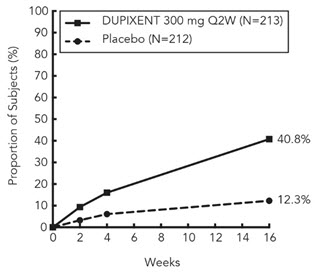
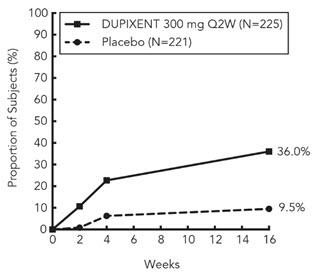
In Trial 3, of the 421 subjects, 353 had been on study for 52 weeks at the time of data analysis. Of these 353 subjects, responders at Week 52 represent a mixture of subjects who maintained their efficacy from Week 16 (e.g., 53% of DUPIXENT IGA 0 or 1 responders at Week 16 remained responders at Week 52) and subjects who were non-responders at Week 16 who later responded to treatment (e.g., 24% of DUPIXENT IGA 0 or 1 non-responders at Week 16 became responders at Week 52). Results of supportive analyses of the 353 subjects in the DUPIXENT with concomitant TCS trial (Trial 3) are presented in Table 6.
Table 6: Efficacy Results (IGA 0 or 1) of DUPIXENT with Concomitant TCS at Week 16 and 52 DUPIXENT
300 mg Q2W + TCSPlacebo + TCS - * In Trial 3, of the 421 randomized and treated subjects, 68 subjects (16%) had not been on study for 52 weeks at the time of data analysis.
- † Responder was defined as a subject with an IGA 0 or 1 ("clear" or "almost clear") and a reduction of ≥2 points on a 0-4 IGA scale.
- ‡ Subjects who received rescue treatment or with missing data were considered as non-responders.
Number of Subjects* 89 264 Responder†,‡ at Week 16 and 52 22% 7% Responder at Week 16 but Non-responder at Week 52 20% 7% Non-responder at Week 16 and Responder at Week 52 13% 6% Non-responder at Week 16 and 52 44% 80% Overall Responder†,‡ Rate at Week 52 36% 13% Treatment effects in subgroups (weight, age, gender, race, and prior treatment, including immunosuppressants) in Trials 1, 2, and 3 were generally consistent with the results in the overall study population.
In Trials 1, 2, and 3, a third randomized treatment arm of DUPIXENT 300 mg QW did not demonstrate additional treatment benefit over DUPIXENT 300 mg Q2W.
Subjects in Trials 1 and 2 who had an IGA 0 or 1 with a reduction of ≥2 points were re-randomized into Trial 5. Trial 5 evaluated multiple DUPIXENT monotherapy dose regimens for maintaining treatment response. The study included subjects randomized to continue with DUPIXENT 300 mg Q2W (62 subjects) or switch to placebo (31 subjects) for 36 weeks. IGA 0 or 1 responses at Week 36 were as follows: 33 (53%) in the Q2W group and 3 (10%) in the placebo group.
Adolescents with Atopic Dermatitis
The efficacy and safety of DUPIXENT monotherapy in adolescent subjects was evaluated in a multicenter, randomized, double-blind, placebo-controlled trial (Trial 6; NCT03054428) in 251 adolescent subjects 12 to 17 years of age, with moderate-to-severe AD defined by an IGA score ≥3 (scale of 0 to 4), an EASI score ≥16 (scale of 0 to 72), and a minimum BSA involvement of ≥10%. Eligible subjects enrolled into this trial had previous inadequate response to topical medication.
Subjects in the DUPIXENT group with baseline weight of <60 kg received an initial dose of 400 mg at Week 0, followed by 200 mg Q2W for 16 weeks. Subjects with baseline weight of ≥60 kg received an initial dose of 600 mg at Week 0, followed by 300 mg Q2W for 16 weeks. Subjects were permitted to receive rescue treatment at the discretion of the investigator. Subjects who received rescue treatment were considered non-responders.
In Trial 6, the mean age was 14.5 years, the median weight was 59.4 kg, 41% of subjects were female, 63% were White, 15% were Asian, and 12% were Black. At baseline 46% of subjects had an IGA score of 3 (moderate AD), 54% had an IGA score of 4 (severe AD), the mean BSA involvement was 57%, and 42% had received prior systemic immunosuppressants. Also, at baseline the mean EASI score was 36, and the weekly averaged Peak Pruritus NRS was 8 on a scale of 0-10. Overall, 92% of subjects had at least one co-morbid allergic condition; 66% had allergic rhinitis, 54% had asthma, and 61% had food allergies.
The primary endpoint was the proportion of subjects with an IGA 0 (clear) or 1 (almost clear) and at least a 2-point improvement from baseline to Week 16. Other evaluated outcomes included the proportion of subjects with EASI-75 or EASI-90 (improvement of at least 75% or 90% in EASI from baseline, respectively), and reduction in itch as measured by the Peak Pruritus NRS (≥4-point improvement).
The efficacy results at Week 16 for Trial 6 are presented in Table 7.
Table 7: Efficacy Results of DUPIXENT in Trial 6 at Week 16 (FAS)* DUPIXENT†
200 mg (<60 kg) or 300 mg (≥60 kg) Q2W
N=82*Placebo
N=85*- * Full Analysis Set (FAS) includes all subjects randomized.
- † At Week 0, subjects received 400 mg (baseline weight <60 kg) or 600 mg (baseline weight ≥60 kg) of DUPIXENT.
- ‡ Responder was defined as a subject with an IGA 0 or 1 ("clear" or "almost clear") and a reduction of ≥2 points on a 0-4 IGA scale.
- § Subjects who received rescue treatment or with missing data were considered as non-responders (59% and 21% in the placebo and DUPIXENT arms, respectively).
IGA 0 or 1‡,§ 24% 2% EASI-75§ 42% 8% EASI-90§ 23% 2% Peak Pruritus NRS (≥4-point improvement)§ 37% 5% A greater proportion of subjects randomized to DUPIXENT achieved an improvement in the Peak Pruritus NRS compared to placebo (defined as ≥4-point improvement at Week 4). See Figure 2.
- * In the primary analyses of the efficacy endpoints, subjects who received rescue treatment or with missing data were considered non-responders.
- † Full Analysis Set (FAS) includes all subjects randomized.
Figure 2: Proportion of Adolescent Subjects with ≥4-point Improvement on the Peak Pruritus NRS in Trial 6* (FAS)† 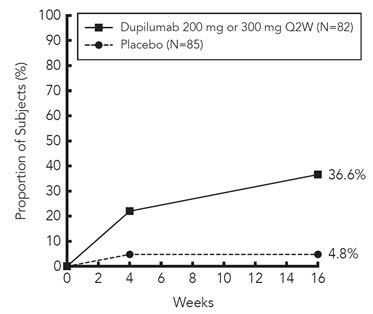
14.2 Asthma
The asthma development program included three randomized, double-blind, placebo-controlled, parallel-group, multi-center trials (AS Trials 1, 2, and 3) of 24 to 52 weeks in treatment duration which enrolled a total of 2888 subjects (12 years of age and older). Subjects enrolled in AS Trials 1 and 2 were required to have a history of 1 or more asthma exacerbations that required treatment with systemic corticosteroids or emergency department visit or hospitalization for the treatment of asthma in the year prior to trial entry. Subjects enrolled in AS Trial 3 required dependence on daily oral corticosteroids in addition to regular use of high-dose inhaled corticosteroids plus an additional controller(s). In all 3 trials, subjects were enrolled without requiring a minimum baseline blood eosinophil count. In AS Trials 2 and 3 subjects with screening blood eosinophil level of >1500 cells/mcL (<1.3%) were excluded. DUPIXENT was administered as add-on to background asthma treatment. Subjects continued background asthma therapy throughout the duration of the studies, except in AS Trial 3 in which OCS dose was tapered as described below.
AS Trial 1
AS Trial 1 was a 24-week dose-ranging study which included 776 subjects (18 years of age and older). DUPIXENT compared with placebo was evaluated in adult subjects with moderate-to-severe asthma on a medium or high-dose inhaled corticosteroid and a long acting beta agonist. Subjects were randomized to receive either 200 mg (N=150) or 300 mg (N=157) DUPIXENT every other week (Q2W) or 200 mg (N=154) or 300 mg (N=157) DUPIXENT every 4 weeks following an initial dose of 400 mg, 600 mg or placebo (N=158), respectively. The primary endpoint was mean change from baseline to Week 12 in FEV1 (L) in subjects with baseline blood eosinophils ≥300 cells/mcL. Other endpoints included percent change from baseline in FEV1 and annualized rate of severe asthma exacerbation events during the 24-week placebo controlled treatment period. Results were evaluated in the overall population and subgroups based on baseline blood eosinophil count (≥300 cells/mcL and <300 cells/mcL). Additional secondary endpoints included responder rates in the patient reported Asthma Control Questionnaire (ACQ-5) and Asthma Quality of Life Questionnaire, Standardized Version (AQLQ(S)) scores.
AS Trial 2
AS Trial 2 was a 52-week study which included 1902 subjects (12 years of age and older). DUPIXENT compared with placebo was evaluated in 107 adolescent and 1795 adult subjects with moderate-to-severe asthma on a medium or high-dose inhaled corticosteroid (ICS) and a minimum of one and up to two additional controller medications. Subjects were randomized to receive either 200 mg (N=631) or 300 mg (N=633) DUPIXENT Q2W (or matching placebo for either 200 mg [N=317] or 300 mg [N=321] Q2W) following an initial dose of 400 mg, 600 mg or placebo respectively. The primary endpoints were the annualized rate of severe exacerbation events during the 52-week placebo controlled period and change from baseline in pre-bronchodilator FEV1 at Week 12 in the overall population (unrestricted by minimum baseline blood eosinophils count). Additional secondary endpoints included annualized severe exacerbation rates and FEV1 in patients with different baseline levels of blood eosinophils as well as responder rates in the ACQ-5 and AQLQ(S) scores.
AS Trial 3
AS Trial 3 was a 24-week oral corticosteroid-reduction study in 210 subjects with asthma who required daily oral corticosteroids in addition to regular use of high dose inhaled corticosteroids plus an additional controller. After optimizing the OCS dose during the screening period, subjects received 300 mg DUPIXENT (N=103) or placebo (N=107) once Q2W for 24 weeks following an initial dose of 600 mg or placebo. Subjects continued to receive their existing asthma medicine during the study; however their OCS dose was reduced every 4 weeks during the OCS reduction phase (Week 4-20), as long as asthma control was maintained. The primary endpoint was the percent reduction of oral corticosteroid dose at Weeks 20 to 24 compared with the baseline dose, while maintaining asthma control in the overall population (unrestricted by minimum baseline blood eosinophils count). Additional secondary endpoints included the annualized rate of severe exacerbation events during treatment period and responder rate in the ACQ-5 and AQLQ(S) scores.
The demographics and baseline characteristics of these 3 trials are provided in Table 8 below.
Table 8: Demographics and Baseline Characteristics of Asthma Trials Parameter Trial 1
(N=776)Trial 2
(N=1902)Trial 3
(N=210)ICS = inhaled corticosteroid; FEV1 = Forced expiratory volume in 1 second; AD = atopic dermatitis; NP = nasal polyposis; AR = allergic rhinitis; FeNO = fraction of exhaled nitric oxide Mean age (years) (SD) 49 (13) 48 (15) 51 (13) % Female 63 63 61 % White 78 83 94 Duration of Asthma (years), mean (± SD) 22 (15) 21 (15) 20 (14) Never smoked (%) 77 81 81 Mean exacerbations in previous year (± SD) 2.2 (2.1) 2.1 (2.2) 2.1 (2.2) High dose ICS use (%) 50 52 89 Pre-dose FEV1 (L) at baseline (± SD) 1.84 (0.54) 1.78 (0.60) 1.58 (0.57) Mean percent predicted FEV1 at baseline (%) (± SD) 61 (11) 58 (14) 52 (15) % Reversibility (± SD) 27 (15) 26 (22) 19 (23) Atopic Medical History % Overall
(AD %, NP %, AR %)73
(8, 11, 62)78
(10, 13, 69)72
(8, 21, 56)Mean FeNO ppb (± SD) 39 (35) 35 (33) 38 (31) Mean total IgE IU/mL (± SD) 435 (754) 432 (747) 431 (776) Mean baseline blood Eosinophil count (± SD) cells/mcL 350 (430) 360 (370) 350 (310) Exacerbations
AS Trials 1 and 2 evaluated the frequency of severe asthma exacerbations defined as deterioration of asthma requiring the use of systemic corticosteroids for at least 3 days or hospitalization or emergency room visit due to asthma that required systemic corticosteroids. In the primary analysis population (subjects with baseline blood eosinophil count of ≥300 cells/mcL in AS Trial 1 and the overall population in AS Trial 2), subjects receiving either DUPIXENT 200 mg or 300 mg Q2W had significant reductions in the rate of asthma exacerbations compared to placebo. In the overall population in AS Trial 2, the rate of severe exacerbations was 0.46 and 0.52 for DUPIXENT 200 mg Q2W and 300 mg Q2W, respectively, compared to matched placebo rates of 0.87 and 0.97. The rate ratio of severe exacerbations compared to placebo was 0.52 (95% CI: 0.41, 0.66) and 0.54 (95% CI: 0.43, 0.68) for DUPIXENT 200 mg Q2W and 300 mg Q2W, respectively. Results in subjects with baseline blood eosinophil counts ≥300 cells/mcL in AS Trials 1 and 2 are shown in Table 9.
Response rates by baseline blood eosinophils for AS Trial 2 are shown in Figure 3. Pre-specified subgroup analyses of AS Trials 1 and 2 demonstrated that there were greater reductions in severe exacerbations in subjects with higher baseline blood eosinophil levels. In AS Trial 2, reductions in exacerbations were significant in the subgroup of subjects with baseline blood eosinophils ≥150 cells/mcL. In subjects with baseline blood eosinophil count <150 cells/mcL, similar severe exacerbation rates were observed between DUPIXENT and placebo.
In AS Trial 2, the estimated rate ratio of exacerbations leading to hospitalizations and/or emergency room visits versus placebo was 0.53 (95% CI: 0.28, 1.03) and 0.74 (95% CI: 0.32, 1.70) with DUPIXENT 200 mg or 300 mg Q2W, respectively.
Table 9: Rate of Severe Exacerbations in AS Trials 1 and 2 Trial Treatment Baseline Blood EOS ≥300 cells/mcL
(primary analysis population, Trial 1)N Rate
(95% CI)Rate Ratio (95% CI) AS Trial 1 DUPIXENT
200 mg Q2W65 0.30
(0.13, 0.68)0.29
(0.11, 0.76)DUPIXENT
300 mg Q2W64 0.20
(0.08, 0.52)0.19
(0.07, 0.56)Placebo 68 1.04
(0.57, 1.90)AS Trial 2 DUPIXENT
200 mg Q2W264 0.37
(0.29, 0.48)0.34
(0.24, 0.48)Placebo 148 1.08
(0.85, 1.38)DUPIXENT
300 mg Q2W277 0.40
(0.32, 0.51)0.33
(0.23, 0.45)Placebo 142 1.24
(0.97, 1.57)Figure 3: Relative Risk in Annualized Event Rate of Severe Exacerbations across Baseline Blood Eosinophil Count (cells/mcL) in AS Trial 2
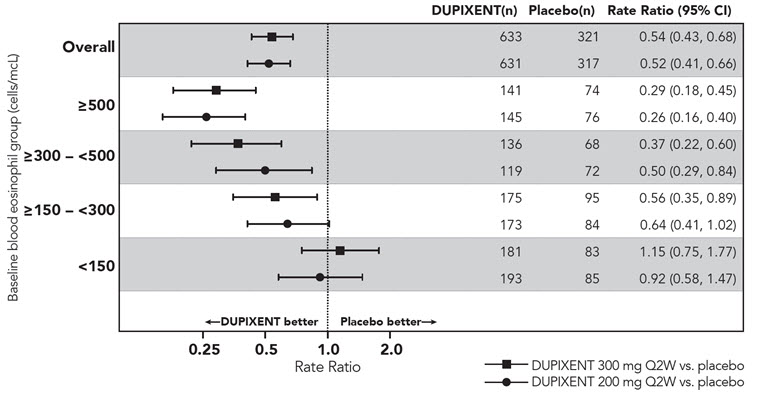
The time to first exacerbation was longer for the subjects receiving DUPIXENT compared to placebo in AS Trial 2 (Figure 4).
Lung Function
Significant increases in pre-bronchodilator FEV1 were observed at Week 12 for AS Trials 1 and 2 in the primary analysis populations (subjects with baseline blood eosinophil count of ≥300 cells/mcL in AS Trial 1 and the overall population in AS Trial 2). In the overall population in AS Trial 2, the FEV1 LS mean change from baseline was 0.32 L (21%) and 0.34 L (23%) for DUPIXENT 200 mg Q2W and 300 mg Q2W, respectively, compared to matched placebo means of 0.18 L (12%) and 0.21 L (14%). The mean treatment difference versus placebo was 0.14 L (95% CI: 0.08, 0.19) and 0.13 L (95% CI: 0.08, 0.18) for DUPIXENT 200 mg Q2W and 300 mg Q2W, respectively. Results in subjects with baseline blood eosinophil counts ≥300 cells/mcL in AS Trials 1 and 2 are shown in Table 10.
Improvements in FEV1 by baseline blood eosinophils for AS Trial 2 are shown in Figure 5. Subgroup analysis of AS Trials 1 and 2 demonstrated greater improvement in subjects with higher baseline blood eosinophils.
Table 10: Mean Change from Baseline and vs Placebo in Pre-Bronchodilator FEV1 at Week 12 in AS Trials 1 and 2 Trial Treatment Baseline Blood EOS ≥300 cells/mcL
(primary analysis population, Trial 1)N LS Mean Change from baseline
L (%)LS Mean Difference vs. placebo
(95% CI)AS Trial 1 DUPIXENT
200 mg Q2W65 0.43 (25.9) 0.26
(0.11, 0.40)DUPIXENT
300 mg Q2W64 0.39 (25.8) 0.21
(0.06, 0.36)Placebo 68 0.18 (10.2) AS Trial 2 DUPIXENT
200 mg Q2W264 0.43 (29.0) 0.21
(0.13, 0.29)Placebo 148 0.21 (15.6) DUPIXENT
300 mg Q2W277 0.47 (32.5) 0.24
(0.16, 0.32)Placebo 142 0.22 (14.4) Figure 5: LS Mean Difference in Change from Baseline vs Placebo to Week 12 in Pre-Bronchodilator FEV1 across Baseline Blood Eosinophil Counts (cells/mcL) in AS Trial 2
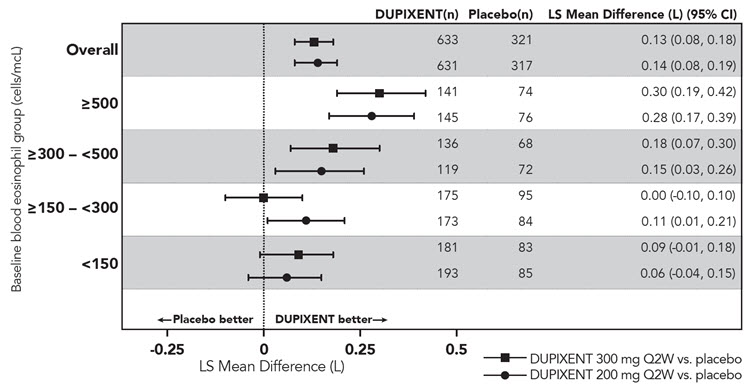
Mean changes in FEV1 over time in AS Trial 2 are shown in Figure 6.
Figure 6: Mean Change from Baseline in Pre-Bronchodilator FEV1 (L) Over Time in Subjects with Baseline Blood Eosinophils ≥300 cells/mcL (AS Trial 2)
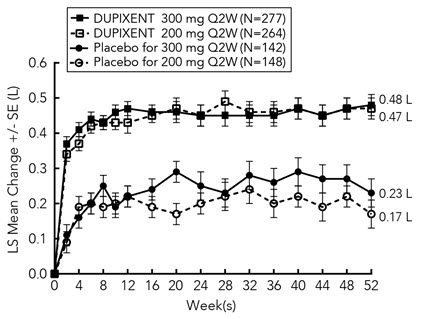
Additional Secondary Endpoints
ACQ-5 and AQLQ(S) were assessed in AS Trial 2 at 52 weeks. The responder rate was defined as an improvement in score of 0.5 or more (scale range 0-6 for ACQ-5 and 1-7 for AQLQ(S)).
- The ACQ-5 responder rate for DUPIXENT 200 mg and 300 mg Q2W in the overall population was 69% vs 62% placebo (odds ratio 1.37; 95% CI: 1.01, 1.86) and 69% vs 63% placebo (odds ratio 1.28; 95% CI: 0.94, 1.73), respectively; and the AQLQ(S) responder rates were 62% vs 54% placebo (odds ratio 1.61; 95% CI: 1.17, 2.21) and 62% vs 57% placebo (odds ratio 1.33; 95% CI: 0.98, 1.81), respectively.
- The ACQ-5 responder rate for DUPIXENT 200 mg and 300 mg Q2W in subjects with baseline blood eosinophils ≥300 cells/mcL was 75% vs 67% placebo (odds ratio: 1.46; 95% CI: 0.90, 2.35) and 71% vs 64% placebo (odds ratio: 1.39; 95% CI: 0.88, 2.19), respectively; and the AQLQ(S) responder rates were 71% vs 55% placebo (odds ratio: 2.02; 95% CI: 1.24, 3.32) and 65% vs 55% placebo (odds ratio: 1.79; 95% CI: 1.13, 2.85), respectively.
Oral Corticosteroid Reduction (AS Trial 3)
AS Trial 3 evaluated the effect of DUPIXENT on reducing the use of maintenance oral corticosteroids. The baseline mean oral corticosteroid dose was 12 mg in the placebo group and 11 mg in the group receiving DUPIXENT. The primary endpoint was the percent reduction from baseline of the final oral corticosteroid dose at Week 24 while maintaining asthma control.
Compared with placebo, subjects receiving DUPIXENT achieved greater reductions in daily maintenance oral corticosteroid dose, while maintaining asthma control. The mean percent reduction in daily OCS dose from baseline was 70% (median 100%) in subjects receiving DUPIXENT (95% CI: 60%, 80%) compared to 42% (median 50%) in subjects receiving placebo (95% CI: 33%, 51%). Reductions of 50% or higher in the OCS dose were observed in 82 (80%) subjects receiving DUPIXENT compared to 57 (53%) in those receiving placebo. The proportion of subjects with a mean final dose less than 5 mg at Weeks 24 was 72% for DUPIXENT and 37% for placebo (odds ratio 4.48 95% CI: 2.39, 8.39). A total of 54 (52%) subjects receiving DUPIXENT versus 31 (29%) subjects in the placebo group had a 100% reduction in their OCS dose.
In this 24-week trial, asthma exacerbations (defined as a temporary increase in oral corticosteroid dose for at least 3 days) were lower in subjects receiving DUPIXENT compared with those receiving placebo (annualized rate 0.65 and 1.60 for the DUPIXENT and placebo group, respectively; rate ratio 0.41 [95% CI 0.26, 0.63]) and improvement in pre-bronchodilator FEV1 from baseline to Week 24 was greater in subjects receiving DUPIXENT compared with those receiving placebo (LS mean difference for DUPIXENT versus placebo of 0.22 L [95% CI: 0.09 to 0.34 L]). Effects on lung function and on oral steroid and exacerbation reduction were similar irrespective of baseline blood eosinophil levels. The ACQ-5 and AQLQ(S) were also assessed in AS Trial 3 and showed improvements similar to those in AS Trial 2.
14.3 Chronic Rhinosinusitis with Nasal Polyposis
The chronic rhinosinusitis with nasal polyposis (CRSwNP) development program included two randomized, double-blind, parallel-group, multicenter, placebo-controlled studies (CSNP Trial 1 and CSNP Trial 2) in 724 subjects aged 18 years and older on background intranasal corticosteroids (INCS). These studies included subjects with CRSwNP despite prior sino-nasal surgery or treatment with, or who were ineligible to receive or were intolerant to, systemic corticosteroids in the past 2 years. Patients with chronic rhinosinusitis without nasal polyposis were not included in these trials. Rescue with systemic corticosteroids or surgery was allowed during the studies at the investigator's discretion. In CSNP Trial 1, a total of 276 subjects were randomized to receive either 300 mg DUPIXENT (N=143) or placebo (N=133) every other week for 24 weeks. In CSNP Trial 2, 448 subjects were randomized to receive either 300 mg DUPIXENT (N=150) every other week for 52 weeks, 300 mg DUPIXENT (N=145) every other week until week 24 followed by 300 mg DUPIXENT every 4 weeks until week 52, or placebo (N=153). All subjects had evidence of sinus opacification on the Lund Mackay (LMK) sinus CT scan and 73% to 90% of subjects had opacification of all sinuses. Subjects were stratified based on their histories of prior surgery and co-morbid asthma/nonsteroidal anti-inflammatory drug exacerbated respiratory disease (NSAID-ERD). A total of 63% of subjects reported previous sinus surgery, with a mean number of 2.0 prior surgeries, 74% used systemic corticosteroids in the previous 2 years with a mean number of 1.6 systemic corticosteroid courses in the previous 2 years, 59% had co-morbid asthma, and 28% had NSAID-ERD.
The co-primary efficacy endpoints were change from baseline to Week 24 in bilateral endoscopic nasal polyps score (NPS; 0-8 scale) as graded by central blinded readers, and change from baseline to Week 24 in nasal congestion/obstruction score averaged over 28 days (NC; 0-3 scale), as determined by subjects using a daily diary. For NPS, polyps on each side of the nose were graded on a categorical scale (0=no polyps; 1=small polyps in the middle meatus not reaching below the inferior border of the middle turbinate; 2=polyps reaching below the lower border of the middle turbinate; 3=large polyps reaching the lower border of the inferior turbinate or polyps medial to the middle turbinate; 4=large polyps causing complete obstruction of the inferior nasal cavity). The total score was the sum of the right and left scores. Nasal congestion was rated daily by the subjects on a 0 to 3 categorical severity scale (0=no symptoms; 1=mild symptoms; 2=moderate symptoms; 3=severe symptoms).
In both studies, key secondary end-points at Week 24 included change from baseline in: LMK sinus CT scan score, daily loss of smell, and 22-item sino-nasal outcome test (SNOT-22). The LMK sinus CT scan score evaluated the opacification of each sinus using a 0 to 2 scale (0=normal; 1=partial opacification; 2=total opacification) deriving a maximum score of 12 per side and a total maximum score of 24 (higher scores indicate more opacification). Loss of smell was scored reflectively by the patient every morning on a 0-3 scale (0=no symptoms, 1=mild symptoms, 2=moderate symptoms, 3=severe symptoms). SNOT-22 includes 22 items assessing symptoms and symptom impact associated with CRSwNP with each item scored from 0 (no problem) to 5 (problem as bad as it can be) with a global score ranging from 0 to 110. SNOT-22 had a 2 week recall period. In the pooled efficacy results, the reduction in the proportion of subjects rescued with systemic corticosteroids and/or sino-nasal surgery (up to Week 52) were evaluated.
The demographics and baseline characteristics of these 2 trials are provided in Table 11 below.
Table 11: Demographics and Baseline Characteristics of CRSwNP Trials Parameter CSNP
Trial 1
(N=276)CSNP
Trial 2
(N=448)SD = standard deviation; AM = morning; NPS = nasal polyps score; SNOT-22 = 22-item sino-nasal outcome test; NSAID-ERD = asthma/nonsteroidal anti-inflammatory drug exacerbated respiratory disease - * Higher scores indicate greater disease severity
Mean age (years) (SD) 50 (13) 52 (12) % Male 57 62 Mean CRSwNP duration (years) (SD) 11 (9) 11 (10) Patients with ≥ 1 prior surgery (%) 72 58 Patients with systemic corticosteroid use in the previous 2 years (%) 65 80 Mean Bilateral endoscopic NPS* (SD), range 0-8 5.8 (1.3) 6.1 (1.2) Mean Nasal congestion (NC) score* (SD), range 0-3 2.4 (0.6) 2.4 (0.6) Mean LMK sinus CT total score* (SD), range 0-24 19 (4.4) 18 (3.8) Mean loss of smell score* (AM), (SD) range 0-3 2.7 (0.5) 2.8 (0.5) Mean SNOT-22 total score* (SD), range 0-110 49.4 (20.2) 51.9 (20.9) Mean blood eosinophils (cells/mcL) (SD) 440 (330) 430 (350) Mean total IgE IU/mL (SD) 212 (276) 240 (342) Atopic Medical History
% Overall75% 82% Asthma (%) 58 60 NSAID-ERD (%) 30 27 Clinical Response (CSNP Trial 1 and CSNP Trial 2)
The results for primary endpoints in CRSwNP studies are presented in Table 12.
Table 12: Results of the Primary Endpoints in CRSwNP Trials CSNP Trial 1 CSNP Trial 2 Placebo
(n=133)DUPIXENT
300 mg Q2W
(n=143)LS mean difference vs. Placebo
(95% CI)Placebo
(n=153)DUPIXENT
300 mg Q2W
(n=295)LS mean difference vs. Placebo
(95% CI)Primary Endpoints at Week 24 Scores Baseline mean LS mean change Baseline mean LS mean change Baseline mean LS mean change Baseline mean LS mean change A reduction in score indicates improvement.
NPS = nasal polyps score; NC = nasal congestion/obstructionNPS 5.86 0.17 5.64 -1.89 -2.06
(-2.43, -1.69)5.96 0.10 6.18 -1.71 -1.80
(-2.10, -1.51)NC 2.45 -0.45 2.26 -1.34 -0.89
(-1.07, -0.71)2.38 -0.38 2.46 -1.25 -0.87
(-1.03, -0.71)Statistically significant efficacy was observed in CSNP Trial 2 with regard to improvement in bilateral endoscopic NPS score at week 24 and week 52 (see Figure 7).
Figure 7: LS Mean Change from Baseline in Bilateral Nasal Polyps Score (NPS) up to Week 52 in CSNP Trial 2 - ITT Population

Similar results were seen in CSNP Trial 1 at Week 24. In the post-treatment period when subjects were off DUPIXENT, the treatment effect diminished over time (see Figure 8).
Figure 8: LS Mean Change from Baseline in Bilateral Nasal Polyps Score (NPS) up to Week 48 in CSNP Trial 1 - ITT Population
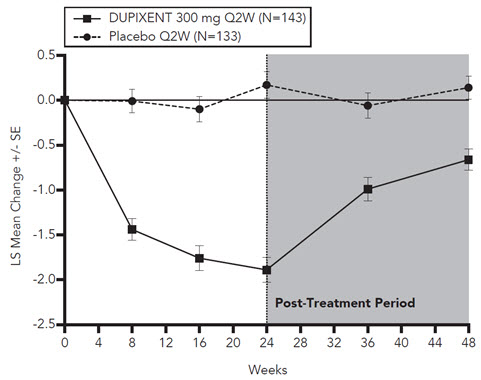
At Week 52, the LS mean difference for nasal congestion in the DUPIXENT group versus placebo was -0.98 (95% CI -1.17, -0.79). In both studies, significant improvements in nasal congestion were observed as early as the first assessment at Week 4. The LS mean difference for nasal congestion at Week 4 in the DUPIXENT group versus placebo was -0.41 (95% CI: -0.52, -0.30) in CSNP Trial 1 and -0.37 (95% CI: -0.46, -0.27) in CSNP Trial 2.
A significant decrease in the LMK sinus CT scan score was observed. The LS mean difference for LMK sinus CT scan score at Week 24 in the DUPIXENT group versus placebo was -7.44 (95% CI: -8.35, -6.53) in CSNP Trial 1 and -5.13 (95% CI: -5.80, -4.46) in CSNP Trial 2. At Week 52, in CSNP Trial 2 the LS mean difference for LMK sinus CT scan score in the DUPIXENT group versus placebo was -6.94 (95% CI: -7.87, -6.01).
Dupilumab significantly improved the loss of smell compared to placebo. The LS mean difference for loss of smell at Week 24 in the DUPIXENT group versus placebo was -1.12 (95% CI: -1.31, -0.93) in CSNP Trial 1 and -0.98 (95% CI: -1.15, -0.81) in CSNP Trial 2. At Week 52, the LS mean difference for loss of smell in the DUPIXENT group versus placebo was -1.10 (95% CI -1.31, -0.89). In both studies, significant improvements in daily loss of smell severity were observed as early as the first assessment at Week 4.
Dupilumab significantly decreased sino-nasal symptoms as measured by SNOT-22 compared to placebo. The LS mean difference for SNOT-22 at Week 24 in the DUPIXENT group versus placebo was -21.12 (95% CI: -25.17, -17.06) in CSNP Trial 1 and -17.36 (95% CI: -20.87, -13.85) in CSNP Trial 2. At Week 52, the LS mean difference in the DUPIXENT group versus placebo was -20.96 (95% CI -25.03, -16.89).
In the pre-specified multiplicity-adjusted pooled analysis of two studies, treatment with DUPIXENT resulted in significant reduction of systemic corticosteroid use and need for sino-nasal surgery versus placebo (HR of 0.24; 95% CI: 0.17, 0.35) (see Figure 9). The proportion of subjects who required systemic corticosteroids was reduced by 74% (HR of 0.26; 95% CI: 0.18, 0.38). The total number of systemic corticosteroid courses per year was reduced by 75% (RR of 0.25; 95% CI: 0.17, 0.37). The proportion of subjects who required surgery was reduced by 83% (HR of 0.17; 95% CI: 0.07, 0.46).
Figure 9: Kaplan Meier Curve for Time to First Systemic Corticosteroid Use and/or Sino-Nasal Surgery During Treatment Period - ITT population CSNP Trial 1 and CSNP Trial 2 Pooled
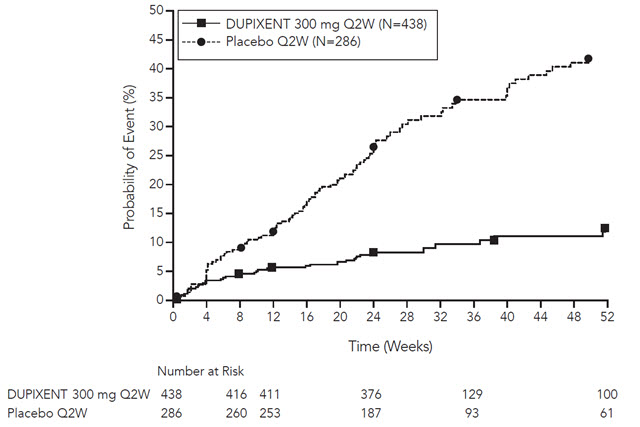
The effects of DUPIXENT on the primary endpoints of NPS and nasal congestion and the key secondary endpoint of LMK sinus CT scan score were consistent in patients with prior surgery and without prior surgery.
In subjects with co-morbid asthma, improvements in pre-bronchodilator FEV1 were similar to patients in the asthma program.
-
16 HOW SUPPLIED/STORAGE AND HANDLING
16.1 How Supplied
DUPIXENT (dupilumab) Injection is a clear to slightly opalescent, colorless to pale yellow solution, supplied in single-dose pre-filled syringes with needle shield. Each pre-filled syringe with needle shield is designed to deliver either 300 mg of DUPIXENT in 2 mL (NDC: 0024-5914-00) or 200 mg of DUPIXENT in 1.14 mL solution (NDC: 0024-5918-00).
DUPIXENT is available in cartons containing 2 pre-filled syringes with needle shield.
Pack Size 300 mg/2 mL Pre-filled Syringe with Needle Shield 200 mg/1.14 mL Pre-filled Syringe with Needle Shield Pack of 2 syringes NDC: 0024-5914-01 NDC: 0024-5918-01 16.2 Storage and Handling
DUPIXENT is sterile and preservative-free. Discard any unused portion.
Store refrigerated at 36°F to 46°F (2°C to 8°C) in the original carton to protect from light.
If necessary, pre-filled syringes may be kept at room temperature up to 77°F (25°C) for a maximum of 14 days. Do not store above 77°F (25°C). After removal from the refrigerator, DUPIXENT must be used within 14 days or discarded.
Do not expose the pre-filled syringe to heat or direct sunlight.
Do NOT freeze. Do NOT shake.
-
17 PATIENT COUNSELING INFORMATION
Advise the patient to read the FDA-approved patient labeling (Patient Information and Instructions for Use).
Pregnancy Registry
There is a pregnancy exposure registry that monitors pregnancy outcomes in women exposed to DUPIXENT during pregnancy. Encourage participation in the registry. [see Use in Specific Populations (8.1)].
Administration Instructions
Provide proper training to patients and/or caregivers on proper subcutaneous injection technique, including aseptic technique, and the preparation and administration of DUPIXENT prior to use. Advise patients to follow sharps disposal recommendations [see Instructions for Use].
Hypersensitivity
Advise patients to discontinue DUPIXENT and to seek immediate medical attention if they experience any symptoms of systemic hypersensitivity reactions [see Warnings and Precautions (5.1)].
Conjunctivitis and Keratitis
Advise patients to consult their healthcare provider if new onset or worsening eye symptoms develop [see Warnings and Precautions (5.2)].
Eosinophilic Conditions
Advise patients to notify their healthcare provider if they present with clinical features of eosinophilic pneumonia or vasculitis consistent with eosinophilic granulomatosis with polyangiitis [see Warnings and Precautions (5.3)].
Not for Acute Asthma Symptoms or Deteriorating Disease
Inform patients that DUPIXENT does not treat acute asthma symptoms or acute exacerbations. Inform patients to seek medical advice if their asthma remains uncontrolled or worsens after initiation of treatment with DUPIXENT [see Warnings and Precautions (5.4)].
Reduction in Corticosteroid Dosage
Inform patients to not discontinue systemic or inhaled corticosteroids except under the direct supervision of a physician. Inform patients that reduction in corticosteroid dose may be associated with systemic withdrawal symptoms and/or unmask conditions previously suppressed by systemic corticosteroid therapy [see Warnings and Precautions (5.5)].
Patients with Co-morbid Asthma
Advise patients with atopic dermatitis or CRSwNP who have co-morbid asthma not to adjust or stop their asthma treatment without talking to their physicians [see Warnings and Precautions (5.6)].
-
SPL UNCLASSIFIED SECTION
Manufactured by:
Regeneron Pharmaceuticals, Inc.
Tarrytown, NY 10591U.S. License No. 1760
Marketed by:
sanofi-aventis U.S. LLC (Bridgewater, NJ 08807) and
Regeneron Pharmaceuticals, Inc. (Tarrytown, NY 10591)DUPIXENT® is a registered trademark of Sanofi Biotechnology
© 2019 Regeneron Pharmaceuticals, Inc. / sanofi-aventis U.S. LLC. All rights reserved.
Revised: June 2019
-
PATIENT PACKAGE INSERT
This Patient Information has been approved by the U.S. Food and Drug Administration. Issued: June 2019 Patient Information
DUPIXENT® (DU-pix'-ent)
(dupilumab)
injection, for subcutaneous useWhat is DUPIXENT?
DUPIXENT is a prescription medicine used:
- to treat people aged 12 years and older with moderate-to-severe atopic dermatitis (eczema) that is not well controlled with prescription therapies used on the skin (topical), or who cannot use topical therapies. DUPIXENT can be used with or without topical corticosteroids.
- with other asthma medicines for the maintenance treatment of moderate-to-severe asthma in people aged 12 years and older whose asthma is not controlled with their current asthma medicines. DUPIXENT helps prevent severe asthma attacks (exacerbations) and can improve your breathing. DUPIXENT may also help reduce the amount of oral corticosteroids you need while preventing severe asthma attacks and improving your breathing.
- with other medicines to treat chronic rhinosinusitis with nasal polyposis in adults whose disease is not controlled.
- DUPIXENT works by blocking two proteins that contribute to a type of inflammation that plays a major role in atopic dermatitis, asthma, and chronic rhinosinusitis with nasal polyposis.
- DUPIXENT is not used to treat sudden breathing problems.
- It is not known if DUPIXENT is safe and effective in children with atopic dermatitis or asthma under 12 years of age.
- It is not known if DUPIXENT is safe and effective in children with chronic rhinosinusitis with nasal polyposis under 18 years of age.
Do not use DUPIXENT if you are allergic to dupilumab or to any of the ingredients in DUPIXENT. See the end of this leaflet for a complete list of ingredients in DUPIXENT.
Before using DUPIXENT, tell your healthcare provider about all your medical conditions, including if you:
- have eye problems.
- have a parasitic (helminth) infection.
- are taking oral, topical, or inhaled corticosteroid medicines. Do not stop taking your corticosteroid medicines unless instructed by your healthcare provider. This may cause other symptoms that were controlled by the corticosteroid medicine to come back.
- are scheduled to receive any vaccinations. You should not receive a "live vaccine" if you are treated with DUPIXENT.
- are pregnant or plan to become pregnant. It is not known whether DUPIXENT will harm your unborn baby.
Pregnancy Registry. There is a pregnancy registry for women who take DUPIXENT during pregnancy. The purpose of this registry is to collect information about your health and your baby's health. You can talk to your healthcare provider or contact 1-877-311-8972 or go to https://mothertobaby.org/ongoing-study/dupixent/ to enroll in this registry or get more information. - are breastfeeding or plan to breastfeed. It is not known whether DUPIXENT passes into your breast milk.
Tell your healthcare provider about all of the medicines you take, including prescription and over-the-counter medicines, vitamins, and herbal supplements. If you have asthma and are taking asthma medicines, do not change or stop your asthma medicine without talking to your healthcare provider.
How should I use DUPIXENT?
- See the detailed "Instructions for Use" that comes with DUPIXENT for information on how to prepare and inject DUPIXENT and how to properly store and throw away (dispose of) used DUPIXENT pre-filled syringes.
- Use DUPIXENT exactly as prescribed by your healthcare provider.
- DUPIXENT comes as a single-dose pre-filled syringe with needle shield.
- DUPIXENT is given as an injection under the skin (subcutaneous injection).
- If your healthcare provider decides that you or a caregiver can give the injections of DUPIXENT, you or your caregiver should receive training on the right way to prepare and inject DUPIXENT. Do not try to inject DUPIXENT until you have been shown the right way by your healthcare provider. In children 12 years of age and older, it is recommended that DUPIXENT be given by or under the supervision of an adult.
- If you miss a dose of DUPIXENT, give the injection within 7 days from the missed dose, then continue with the original schedule. If the missed dose is not given within 7 days, wait until the next scheduled dose to give your DUPIXENT injection.
- If you inject more DUPIXENT than prescribed, call your healthcare provider right away.
- Your healthcare provider may prescribe other medicines to use with DUPIXENT. Use the other prescribed medicines exactly as your healthcare provider tells you to.
What are the possible side effects of DUPIXENT?
DUPIXENT can cause serious side effects, including:
- Allergic reactions (hypersensitivity), including a severe reaction known as anaphylaxis. Stop using DUPIXENT and tell your healthcare provider or get emergency help right away if you get any of the following symptoms:
- breathing problems
- fever
- general ill feeling
- swollen lymph nodes
- swelling of the face, mouth, and tongue
- hives
- itching
- fainting, dizziness, feeling lightheaded (low blood pressure)
- joint pain
- skin rash
- Eye problems. Tell your healthcare provider if you have any new or worsening eye problems, including eye pain or changes in vision.
- Inflammation of your blood vessels. Rarely, this can happen in people with asthma who receive DUPIXENT. This may happen in people who also take a steroid medicine by mouth that is being stopped or the dose is being lowered. It is not known whether this is caused by DUPIXENT. Tell your healthcare provider right away if you have:
- rash
- shortness of breath
- persistent fever
- chest pain
- a feeling of pins and needles or numbness of your arms or legs
The most common side effects of DUPIXENT include:
- injection site reactions
- eye and eyelid inflammation, including redness, swelling, and itching
- pain in the throat (oropharyngeal pain)
- cold sores in your mouth or on your lips
- high count of a certain white blood cell (eosinophilia)
- trouble sleeping (insomnia)
- toothache
- gastritis
- joint pain (arthralgia)
Tell your healthcare provider if you have any side effect that bothers you or that does not go away.
These are not all of the possible side effects of DUPIXENT.
Call your doctor for medical advice about side effects. You may report side effects to FDA at 1-800-FDA-1088.
General information about the safe and effective use of DUPIXENT.
Medicines are sometimes prescribed for purposes other than those listed in a Patient Information leaflet. Do not use DUPIXENT for a condition for which it was not prescribed. Do not give DUPIXENT to other people, even if they have the same symptoms that you have. It may harm them. You can ask your pharmacist or healthcare provider for information about DUPIXENT that is written for health professionals.
What are the ingredients in DUPIXENT?
Active ingredient: dupilumab
Inactive ingredients: L-arginine hydrochloride, L-histidine, polysorbate 80, sodium acetate, sucrose, and water for injection.
REGENERON SANOFI GENZYME
Manufactured by: Regeneron Pharmaceuticals, Inc., Tarrytown, NY 10591 U.S. License No. 1760
Marketed by: sanofi-aventis U.S. LLC (Bridgewater, NJ 08807) and Regeneron Pharmaceuticals, Inc. (Tarrytown, NY 10591)
DUPIXENT® is a registered trademark of Sanofi Biotechnology / © 2019 Regeneron Pharmaceuticals, Inc. / sanofi-aventis U.S. LLC. All rights reserved.
For more information about DUPIXENT, go to www.DUPIXENT.com or call 1-844-DUPIXENT (1-844-387-4936).
-
Instructions for UseDUPIXENT® (DU-pix'-ent)(dupilumab)injection, for subcutaneous useSingle-Dose Pre-filled Syringe with Needle Shield
Read this Instructions for Use before using the DUPIXENT Pre-filled Syringe. Do not inject yourself or someone else until you have been shown how to inject DUPIXENT. In adolescents 12 years of age and older, it is recommended that DUPIXENT be administered by or under supervision of an adult. Your healthcare provider can show you or your caregiver how to prepare and inject a dose of DUPIXENT before you try to do it yourself the first time. Keep these instructions for future use. Call your healthcare provider if you have any questions.
This device is a Single-Dose Pre-filled Syringe (called "DUPIXENT Syringe" in these instructions). It contains 300 mg of DUPIXENT for injection under the skin (subcutaneous injection).
The parts of the DUPIXENT Syringe are shown below:
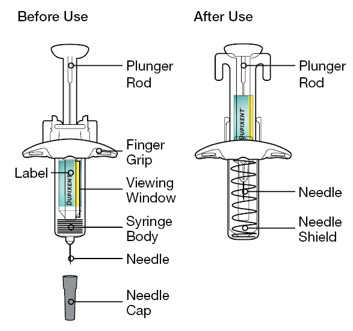
Important Information - Read all of the instructions carefully before using the DUPIXENT Syringe.
- Ask your healthcare provider how often you will need to inject the medicine.
- Rotate the injection site each time you inject.
- Do not use the DUPIXENT Syringe if it has been dropped on a hard surface or damaged.
- Do not use the DUPIXENT Syringe if the Needle Cap is missing or not securely attached.
- Do not touch the Plunger Rod until you are ready to inject.
- Do not inject through clothes.
- Do not get rid of any air bubble in the DUPIXENT Syringe.
- To reduce the risk of accidental needle sticks, each pre-filled syringe has a Needle Shield that is automatically activated to cover the needle after you have given your injection.
- Do not pull back on the Plunger Rod at any time.
- Do not remove the Needle Cap until just before you give the injection.
- Throw away (dispose of) the used DUPIXENT Single-Dose Pre-filled Syringe right away after use. See "Step 13: Dispose" below.
- Do not re-use a DUPIXENT Single-Dose Pre-filled Syringe.
How should I store DUPIXENT? - Keep DUPIXENT Syringes and all medicines out of the reach of children.
- Store DUPIXENT Syringes in the refrigerator between 36°F and 46°F (2°C and 8°C).
- Store DUPIXENT Syringes in the original carton to protect them from light.
- DUPIXENT Syringes can be stored at room temperature up to 77°F (25°C) up to 14 days. Throw away (dispose of) any DUPIXENT Syringes that have been left at room temperature for longer than 14 days.
- Do not shake the DUPIXENT Syringe.
- Do not heat the DUPIXENT Syringe.
- Do not freeze the DUPIXENT Syringe.
- Do not put the DUPIXENT Syringe into direct sunlight.
Step 1: Remove
Remove the DUPIXENT Syringe from the carton by holding the middle of the Syringe Body.
 Do not pull off the Needle Cap until you are ready to inject.
Do not pull off the Needle Cap until you are ready to inject.
 Do not use the DUPIXENT Syringe if it has been dropped on a hard surface or damaged.
Do not use the DUPIXENT Syringe if it has been dropped on a hard surface or damaged.
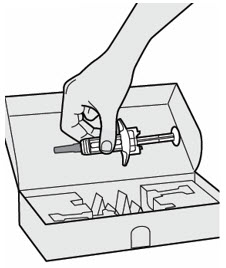
Step 2: Prepare
Ensure you have the following:
- the DUPIXENT Pre-filled Syringe
- 1 alcohol wipe*
- 1 cotton ball or gauze*
- a sharps disposal container* (See Step 13)
*Items not included in the carton
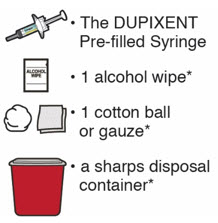
Step 3: Check
When you receive your DUPIXENT Syringes, always check to see that:
- you have the correct medicine and dose.
- the expiration date on the Single-Dose Pre-filled Syringe has not passed.
 Do not use the DUPIXENT Syringe if the expiration date has passed.
Do not use the DUPIXENT Syringe if the expiration date has passed.
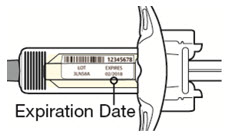
Step 4: Inspect
Look at the medicine through the Viewing Window on the DUPIXENT Syringe:
Check to see if the liquid is clear and colorless to pale yellow.
Note: You may see an air bubble, this is normal.
 Do not use the DUPIXENT Syringe if the liquid is discolored or cloudy, or if it contains visible flakes or particles.
Do not use the DUPIXENT Syringe if the liquid is discolored or cloudy, or if it contains visible flakes or particles.
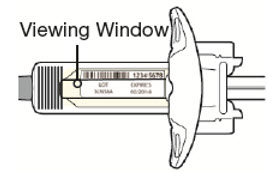
Step 5: Wait 45 minutes
Lay the DUPIXENT Syringe on a flat surface and let it naturally warm to room temperature for at least 45 minutes.
 Do not heat the DUPIXENT Syringe.
Do not heat the DUPIXENT Syringe.
 Do not put the DUPIXENT Syringe into direct sunlight.
Do not put the DUPIXENT Syringe into direct sunlight.
 Do not keep DUPIXENT Syringes at room temperature for more than 14 days. Throw away (dispose of) any DUPIXENT Syringes that have been left at room temperature for longer than 14 days.
Do not keep DUPIXENT Syringes at room temperature for more than 14 days. Throw away (dispose of) any DUPIXENT Syringes that have been left at room temperature for longer than 14 days.
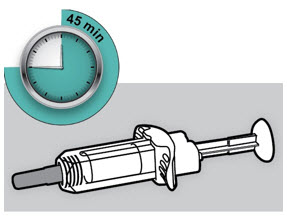
Step 6: Choose your injection site
- You can inject into your thigh or stomach, except for the 2 inches (5 cm) around your belly button (navel).
- If a caregiver injects your dose, they can also use the outer area of the upper arm.
- Choose a different site each time you inject DUPIXENT.
 Do not inject into skin that is tender, damaged, bruised or scarred.
Do not inject into skin that is tender, damaged, bruised or scarred.

Step 7: Clean
Wash your hands.
Clean the injection site with an alcohol wipe.
Let your skin dry before injecting.
 Do not touch the injection site again or blow on it before the injection.
Do not touch the injection site again or blow on it before the injection.

Step 8: Remove Needle Cap
Hold the DUPIXENT Syringe in the middle of the Syringe Body with the Needle pointing away from you and pull off the Needle Cap.
 Do not put the Needle Cap back on.
Do not put the Needle Cap back on.
 Do not touch the Needle.
Do not touch the Needle.
Inject your medicine right away after removing the Needle Cap.
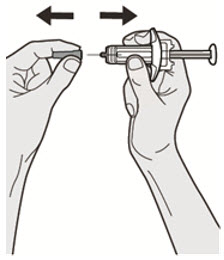
Step 9: Pinch
Pinch a fold of skin at the injection site (thigh or stomach, except 2 inches around your belly button, or outer area of the upper arm if injected by your caregiver). The figure below shows an example of pinching a fold of skin on your stomach.
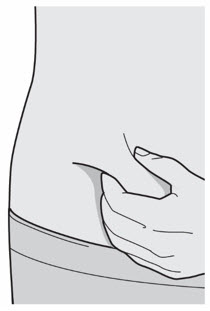
Step 10: Insert
Insert the Needle completely into the fold of the skin at about a 45° angle.

Step 11: Push
Relax the pinch.
Push the Plunger Rod down slowly and steadily as far as it will go until the DUPIXENT Syringe is empty.
Note: You will feel some resistance. This is normal.
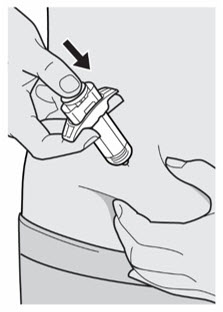
Step 12: Release and Remove
Lift your thumb to release the Plunger Rod until the Needle is covered by the Needle Shield and then remove the Syringe from the injection site.
Lightly press a cotton ball or gauze on the injection site if you see any blood.
 Do not put the Needle Cap back on.
Do not put the Needle Cap back on.
 Do not rub your skin after the injection.
Do not rub your skin after the injection.
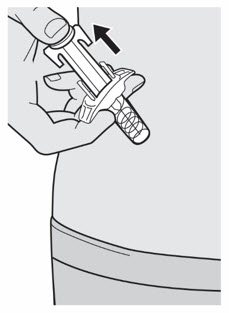
Put your used Needles, DUPIXENT Syringes, and Needle Caps in a FDA-cleared sharps disposal container right away after use.
 Do not dispose of (throw away) Needles, DUPIXENT Syringes, and Needle Caps in your household trash.
Do not dispose of (throw away) Needles, DUPIXENT Syringes, and Needle Caps in your household trash.
If you do not have a FDA-cleared sharps disposal container, you may use a household container that is:
- made of a heavy-duty plastic,
- can be closed with a tight-fitting, puncture-resistant lid, without sharps being able to come out,
- upright and stable during use,
- leak-resistant, and
- properly labeled to warn of hazardous waste inside the container
When your sharps disposal container is almost full, you will need to follow your community guidelines for the right way to dispose of your sharps disposal container. There may be state or local laws about how you should throw away used Needles and Syringes.
For more information about safe sharps disposal, and for specific information about sharps disposal in the state that you live in, go to the FDA's website at: http://www.fda.gov/safesharpsdisposal
Do not dispose of your used sharps disposal container in your household trash unless your community guidelines permit this. Do not recycle your used sharps disposal container.
 Do not put the Needle Cap back on.
Do not put the Needle Cap back on.
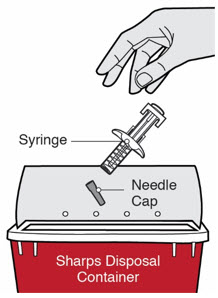
This Instructions for Use has been approved by the U.S. Food and Drug Administration.
REGENERON SANOFI GENZYME
Manufactured by:
Regeneron Pharmaceuticals, Inc.
Tarrytown, NY 10591
U.S. License No. 1760Marketed by:
sanofi-aventis U.S. LLC (Bridgewater, NJ 08807) and
Regeneron Pharmaceuticals, Inc. (Tarrytown, NY 10591)
DUPIXENT® is a registered trademark of Sanofi Biotechnology© 2019 Regeneron Pharmaceuticals, Inc. / sanofi-aventis U.S. LLC. All rights reserved.
Issue Date: March 2019
-
Instructions for UseDUPIXENT® (DU-pix'-ent)(dupilumab)injection, for subcutaneous useSingle-Dose Pre-filled Syringe with Needle Shield
Read this Instructions for Use before using the DUPIXENT Pre-filled Syringe. Do not inject yourself or someone else until you have been shown how to inject DUPIXENT. In adolescents 12 years of age and older, it is recommended that DUPIXENT be administered by or under supervision of an adult. Your healthcare provider can show you or your caregiver how to prepare and inject a dose of DUPIXENT before you try to do it yourself the first time. Keep these instructions for future use. Call your healthcare provider if you have any questions.
This device is a Single-Dose Pre-filled Syringe (called "DUPIXENT Syringe" in these instructions). It contains 200 mg of DUPIXENT for injection under the skin (subcutaneous injection).
The parts of the DUPIXENT Syringe are shown below:
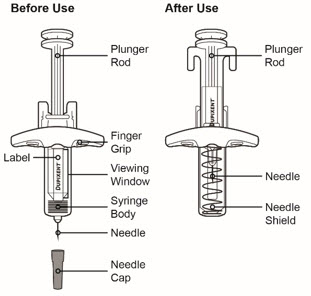
Important Information - Read all of the instructions carefully before using the DUPIXENT Syringe.
- Ask your healthcare provider how often you will need to inject the medicine.
- Rotate the injection site each time you inject.
- Do not use the DUPIXENT Syringe if it has been dropped on a hard surface or damaged.
- Do not use the DUPIXENT Syringe if the Needle Cap is missing or not securely attached.
- Do not touch the Plunger Rod until you are ready to inject.
- Do not inject through clothes.
- Do not get rid of any air bubble in the DUPIXENT Syringe.
- To reduce the risk of accidental needle sticks, each pre-filled syringe has a Needle Shield that is automatically activated to cover the needle after you have given your injection.
- Do not pull back on the Plunger Rod at any time.
- Do not remove the Needle Cap until just before you give the injection.
- Throw away (dispose of) the used DUPIXENT Single-Dose Pre-filled Syringe right away after use. See "Step 13: Dispose" below.
- Do not re-use a DUPIXENT Single-Dose Pre-filled Syringe.
How should I store DUPIXENT? - Keep DUPIXENT Syringes and all medicines out of the reach of children.
- Store DUPIXENT Syringes in the refrigerator between 36°F and 46°F (2°C and 8°C).
- Store DUPIXENT Syringes in the original carton to protect them from light.
- DUPIXENT Syringes can be stored at room temperature up to 77°F (25°C) up to 14 days. Throw away (dispose of) any DUPIXENT Syringes that have been left at room temperature for longer than 14 days.
- Do not shake the DUPIXENT Syringe.
- Do not heat the DUPIXENT Syringe.
- Do not freeze the DUPIXENT Syringe.
- Do not put the DUPIXENT Syringe into direct sunlight.
Step 1: Remove
Remove the DUPIXENT Syringe from the carton by holding the middle of the Syringe Body.
 Do not pull off the Needle Cap until you are ready to inject.
Do not pull off the Needle Cap until you are ready to inject.
 Do not use the DUPIXENT Syringe if it has been dropped on a hard surface or damaged.
Do not use the DUPIXENT Syringe if it has been dropped on a hard surface or damaged.
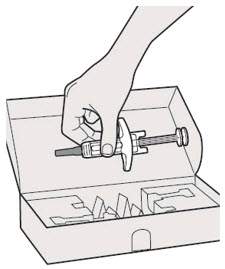
Step 2: Prepare
Ensure you have the following:
- the DUPIXENT Pre-filled Syringe
- 1 alcohol wipe*
- 1 cotton ball or gauze*
- a sharps disposal container* (See Step 13)
*Items not included in the carton
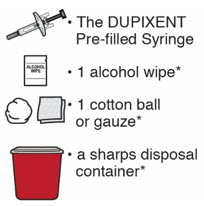
Step 3: Check
When you receive your DUPIXENT Syringes, always check to see that:
- you have the correct medicine and dose.
- the expiration date on the Single-Dose Pre-filled Syringe has not passed.
 Do not use the DUPIXENT Syringe if the expiration date has passed.
Do not use the DUPIXENT Syringe if the expiration date has passed.
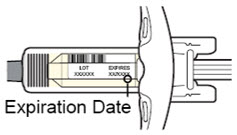
Step 4: Inspect
Look at the medicine through the Viewing Window on the DUPIXENT Syringe:
Check to see if the liquid is clear and colorless to pale yellow.
Note: You may see an air bubble, this is normal.
 Do not use the DUPIXENT Syringe if the liquid is discolored or cloudy, or if it contains visible flakes or particles.
Do not use the DUPIXENT Syringe if the liquid is discolored or cloudy, or if it contains visible flakes or particles.

Step 5: Wait 30 minutes
Lay the DUPIXENT Syringe on a flat surface and let it naturally warm to room temperature for at least 30 minutes.
 Do not heat the DUPIXENT Syringe.
Do not heat the DUPIXENT Syringe.
 Do not put the DUPIXENT Syringe into direct sunlight.
Do not put the DUPIXENT Syringe into direct sunlight.
 Do not keep DUPIXENT Syringes at room temperature for more than 14 days. Throw away (dispose of) any DUPIXENT Syringes that have been left at room temperature for longer than 14 days.
Do not keep DUPIXENT Syringes at room temperature for more than 14 days. Throw away (dispose of) any DUPIXENT Syringes that have been left at room temperature for longer than 14 days.
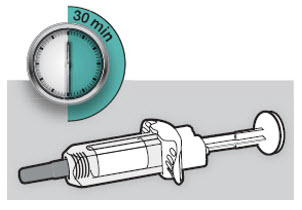
Step 6: Choose your injection site
- You can inject into your thigh or stomach, except for the 2 inches (5 cm) around your belly button (navel).
- If a caregiver injects your dose, they can also use the outer area of the upper arm.
- Choose a different site each time you inject DUPIXENT.
 Do not inject into skin that is tender, damaged, bruised or scarred.
Do not inject into skin that is tender, damaged, bruised or scarred.

Step 7: Clean
Wash your hands.
Clean the injection site with an alcohol wipe.
Let your skin dry before injecting.
 Do not touch the injection site again or blow on it before the injection.
Do not touch the injection site again or blow on it before the injection.
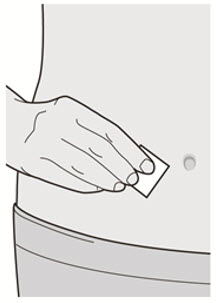
Step 8: Remove Needle Cap
Hold the DUPIXENT Syringe in the middle of the Syringe Body with the Needle pointing away from you and pull off the Needle Cap.
 Do not put the Needle Cap back on.
Do not put the Needle Cap back on.
 Do not touch the Needle.
Do not touch the Needle.
Inject your medicine right away after removing the Needle Cap.
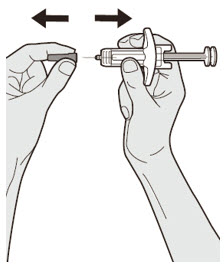
Step 9: Pinch
Pinch a fold of skin at the injection site (thigh or stomach, except 2 inches around your belly button, or outer area of the upper arm if injected by your caregiver). The figure below shows an example of pinching a fold of skin on your stomach.
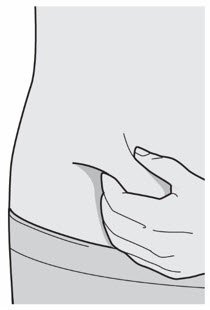
Step 10: Insert
Insert the Needle completely into the fold of the skin at about a 45° angle.
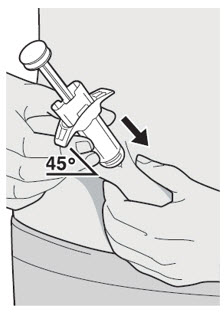
Step 11: Push
Relax the pinch.
Push the Plunger Rod down slowly and steadily as far as it will go until the DUPIXENT Syringe is empty.
Note: You will feel some resistance. This is normal.
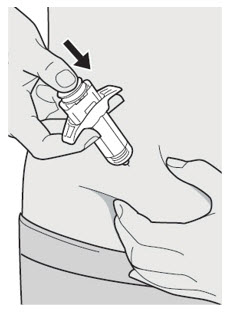
Step 12: Release and Remove
Lift your thumb to release the Plunger Rod until the Needle is covered by the Needle Shield and then remove the Syringe from the injection site.
Lightly press a cotton ball or gauze on the injection site if you see any blood.
 Do not put the Needle Cap back on.
Do not put the Needle Cap back on.
 Do not rub your skin after the injection.
Do not rub your skin after the injection.

Put your used Needles, DUPIXENT Syringes, and Needle Caps in a FDA-cleared sharps disposal container right away after use.
 Do not dispose of (throw away) Needles, DUPIXENT Syringes, and Needle Caps in your household trash.
Do not dispose of (throw away) Needles, DUPIXENT Syringes, and Needle Caps in your household trash.
If you do not have a FDA-cleared sharps disposal container, you may use a household container that is:
- made of a heavy-duty plastic,
- can be closed with a tight-fitting, puncture-resistant lid, without sharps being able to come out,
- upright and stable during use,
- leak-resistant, and
- properly labeled to warn of hazardous waste inside the container
When your sharps disposal container is almost full, you will need to follow your community guidelines for the right way to dispose of your sharps disposal container. There may be state or local laws about how you should throw away used Needles and Syringes.
For more information about safe sharps disposal, and for specific information about sharps disposal in the state that you live in, go to the FDA's website at: http://www.fda.gov/safesharpsdisposal
Do not dispose of your used sharps disposal container in your household trash unless your community guidelines permit this. Do not recycle your used sharps disposal container.
 Do not put the Needle Cap back on.
Do not put the Needle Cap back on.

This Instructions for Use has been approved by the U.S. Food and Drug Administration.
REGENERON SANOFI GENZYME
Manufactured by:
Regeneron Pharmaceuticals, Inc.
Tarrytown, NY 10591
U.S. License No. 1760Marketed by:
sanofi-aventis U.S. LLC (Bridgewater, NJ 08807) and
Regeneron Pharmaceuticals, Inc. (Tarrytown, NY 10591)
DUPIXENT® is a registered trademark of Sanofi Biotechnology© 2019 Regeneron Pharmaceuticals, Inc. / sanofi-aventis U.S. LLC. All rights reserved.
Issue Date: March 2019
-
PRINCIPAL DISPLAY PANEL - 300 mg/2 mL Syringe Carton - 5914
NDC: 0024-5914-01
Rx Only
DUPIXENT®
(dupilumab)
Injection300 mg/2 mL (150 mg/mL)
For Subcutaneous Use Only.
300 mg/2 mL
2
Single-dose
Pre-filled Syringes
with Needle ShieldKeep out of reach of children. Do not use after
expiration. Do not use if seal is broken or damaged.Store refrigerated at 36° to 46°F (2° to 8°C) in the original carton.
Dosage and Administration: See package insert for dosage information and directions for use.SANOFI GENZYME
REGENERON
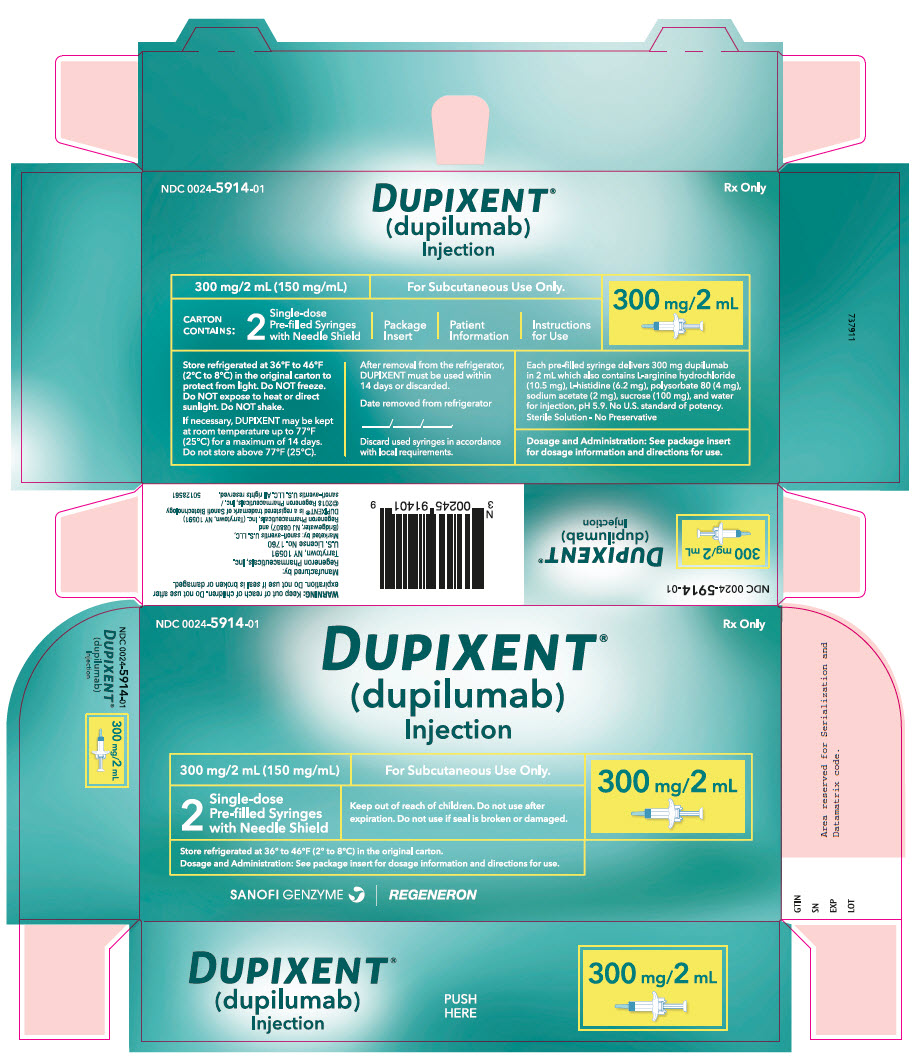
-
PRINCIPAL DISPLAY PANEL - 300 mg/2 mL Syringe Carton - 5916
NDC: 0024-5916-01
Rx Only
DUPIXENT®
(dupilumab)
Injection300 mg/2 mL (150 mg/mL)
For Subcutaneous Injection Only.
300 mg/2 mL
2
Single-dose
Pre-filled SyringesKeep out of reach of children. Do not use after
expiration. Do not use if seal is broken or damaged.Store refrigerated at 36° to 46°F (2° to 8°C) in the original carton.
Dosage and Administration: See package insert for dosage information and directions for use.SANOFI GENZYME
REGENERON
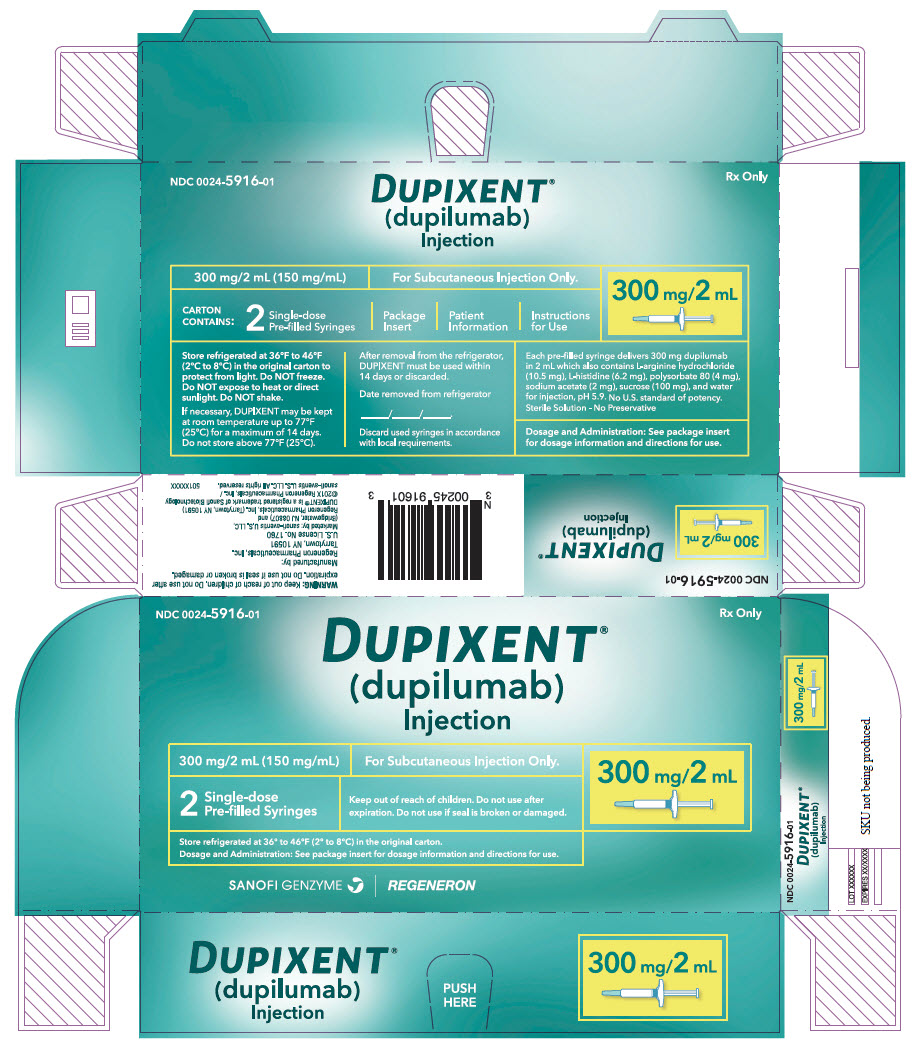
-
PRINCIPAL DISPLAY PANEL - 200 mg/1.14 mL Syringe Carton
NDC: 0024-5918-01
Rx Only
DUPIXENT®
(dupilumab)
Injection200 mg/1.14 mL (175 mg/mL)
For Subcutaneous Use Only.
200 mg/1.14 mL
2
Single-dose
Pre-filled Syringes
with Needle ShieldKeep out of reach of children. Do not use after
expiration. Do not use if seal is broken or damaged.Store refrigerated at 36° to 46°F (2° to 8°C) in the original carton.
Dosage and Administration: See package insert for dosage information and directions for use.SANOFI GENZYME
REGENERON

-
INGREDIENTS AND APPEARANCE
DUPIXENT
dupilumab injection, solutionProduct Information Product Type HUMAN PRESCRIPTION DRUG Item Code (Source) NDC: 0024-5914 Route of Administration SUBCUTANEOUS Active Ingredient/Active Moiety Ingredient Name Basis of Strength Strength Dupilumab (UNII: 420K487FSG) (Dupilumab - UNII:420K487FSG) Dupilumab 300 mg in 2 mL Inactive Ingredients Ingredient Name Strength ARGININE HYDROCHLORIDE (UNII: F7LTH1E20Y) HISTIDINE (UNII: 4QD397987E) polysorbate 80 (UNII: 6OZP39ZG8H) sodium acetate (UNII: 4550K0SC9B) sucrose (UNII: C151H8M554) water (UNII: 059QF0KO0R) Packaging # Item Code Package Description Marketing Start Date Marketing End Date 1 NDC: 0024-5914-01 2 in 1 CARTON 03/28/2017 1 2 mL in 1 SYRINGE, GLASS; Type 3: Prefilled Biologic Delivery Device/System (syringe, patch, etc.) 2 NDC: 0024-5914-02 2 in 1 CARTON 07/01/2018 2 2 mL in 1 SYRINGE, GLASS; Type 3: Prefilled Biologic Delivery Device/System (syringe, patch, etc.) Marketing Information Marketing Category Application Number or Monograph Citation Marketing Start Date Marketing End Date BLA BLA761055 03/28/2017 DUPIXENT
dupilumab injection, solutionProduct Information Product Type HUMAN PRESCRIPTION DRUG Item Code (Source) NDC: 0024-5916 Route of Administration SUBCUTANEOUS Active Ingredient/Active Moiety Ingredient Name Basis of Strength Strength Dupilumab (UNII: 420K487FSG) (Dupilumab - UNII:420K487FSG) Dupilumab 300 mg in 2 mL Inactive Ingredients Ingredient Name Strength ARGININE HYDROCHLORIDE (UNII: F7LTH1E20Y) HISTIDINE (UNII: 4QD397987E) polysorbate 80 (UNII: 6OZP39ZG8H) sodium acetate (UNII: 4550K0SC9B) sucrose (UNII: C151H8M554) water (UNII: 059QF0KO0R) Packaging # Item Code Package Description Marketing Start Date Marketing End Date 1 NDC: 0024-5916-01 2 in 1 CARTON 03/28/2017 1 2 mL in 1 SYRINGE, GLASS; Type 3: Prefilled Biologic Delivery Device/System (syringe, patch, etc.) Marketing Information Marketing Category Application Number or Monograph Citation Marketing Start Date Marketing End Date BLA BLA761055 03/28/2017 DUPIXENT
dupilumab injection, solutionProduct Information Product Type HUMAN PRESCRIPTION DRUG Item Code (Source) NDC: 0024-5918 Route of Administration SUBCUTANEOUS Active Ingredient/Active Moiety Ingredient Name Basis of Strength Strength Dupilumab (UNII: 420K487FSG) (Dupilumab - UNII:420K487FSG) Dupilumab 200 mg in 1.14 mL Inactive Ingredients Ingredient Name Strength ARGININE HYDROCHLORIDE (UNII: F7LTH1E20Y) HISTIDINE (UNII: 4QD397987E) polysorbate 80 (UNII: 6OZP39ZG8H) sodium acetate (UNII: 4550K0SC9B) sucrose (UNII: C151H8M554) water (UNII: 059QF0KO0R) Packaging # Item Code Package Description Marketing Start Date Marketing End Date 1 NDC: 0024-5918-01 2 in 1 CARTON 10/19/2018 1 1.14 mL in 1 SYRINGE, GLASS; Type 3: Prefilled Biologic Delivery Device/System (syringe, patch, etc.) 2 NDC: 0024-5918-02 2 in 1 CARTON 10/19/2018 2 1.14 mL in 1 SYRINGE, GLASS; Type 3: Prefilled Biologic Delivery Device/System (syringe, patch, etc.) Marketing Information Marketing Category Application Number or Monograph Citation Marketing Start Date Marketing End Date BLA BLA761055 10/19/2018 Labeler - sanofi-aventis U.S. LLC (824676584) Establishment Name Address ID/FEI Business Operations Regeneron Pharmaceuticals, Inc. 945589711 API MANUFACTURE(0024-5914, 0024-5916, 0024-5918) , ANALYSIS(0024-5914, 0024-5916, 0024-5918) Establishment Name Address ID/FEI Business Operations Sanofi-Winthrop Industrie 297730488 ANALYSIS(0024-5914, 0024-5916, 0024-5918) , MANUFACTURE(0024-5914, 0024-5916, 0024-5918) , LABEL(0024-5914, 0024-5916, 0024-5918) , PACK(0024-5914, 0024-5916, 0024-5918) Establishment Name Address ID/FEI Business Operations Sanofi-Aventis Deutschland GmbH 313218430 ANALYSIS(0024-5914, 0024-5916, 0024-5918) Establishment Name Address ID/FEI Business Operations Catalent Indiana, LLC 172209277 ANALYSIS(0024-5914, 0024-5916, 0024-5918) , LABEL(0024-5914, 0024-5916, 0024-5918) , PACK(0024-5914, 0024-5916, 0024-5918) , MANUFACTURE(0024-5914, 0024-5916, 0024-5918) Establishment Name Address ID/FEI Business Operations Regeneron Ireland Unlimited Company 985528196 API MANUFACTURE(0024-5914, 0024-5916, 0024-5918) , ANALYSIS(0024-5914, 0024-5916, 0024-5918)
Trademark Results [Dupixent]
Mark Image Registration | Serial | Company Trademark Application Date |
|---|---|
 DUPIXENT 97429846 not registered Live/Pending |
Sanofi Biotechnology 2022-05-26 |
 DUPIXENT 87202613 5235634 Live/Registered |
Sanofi Biotechnology 2016-10-13 |
 DUPIXENT 86807623 4978127 Live/Registered |
Sanofi Biotechnology 2015-11-03 |
© 2026 FDA.report
This site is not affiliated with or endorsed by the FDA.
